2 Plate Tectonics
By the end of this chapter, students should be able to:
- Describe how the ideas behind plate tectonics started with Alfred Wegener’s hypothesis of continental drift.
- Describe the physical and chemical layers of the Earth and how they affect plate movement.
- Explain how movement at the three types of plate boundaries causes earthquakes, volcanoes, and mountain building.
- Identify convergent boundaries, including subduction and collisions, as places where plates come together.
- Identify divergent boundaries, including rifts and mid-ocean ridges, as places where plates separate.
- Explain transform boundaries as places where adjacent plates shear past each other.
- Describe the Wilson Cycle, beginning with continental rifting, ocean basin creation, plate subduction, and ending with ocean basin closure.
- Explain how the tracks of hotspots, places that have continually rising magma, is used to calculate plate motion.
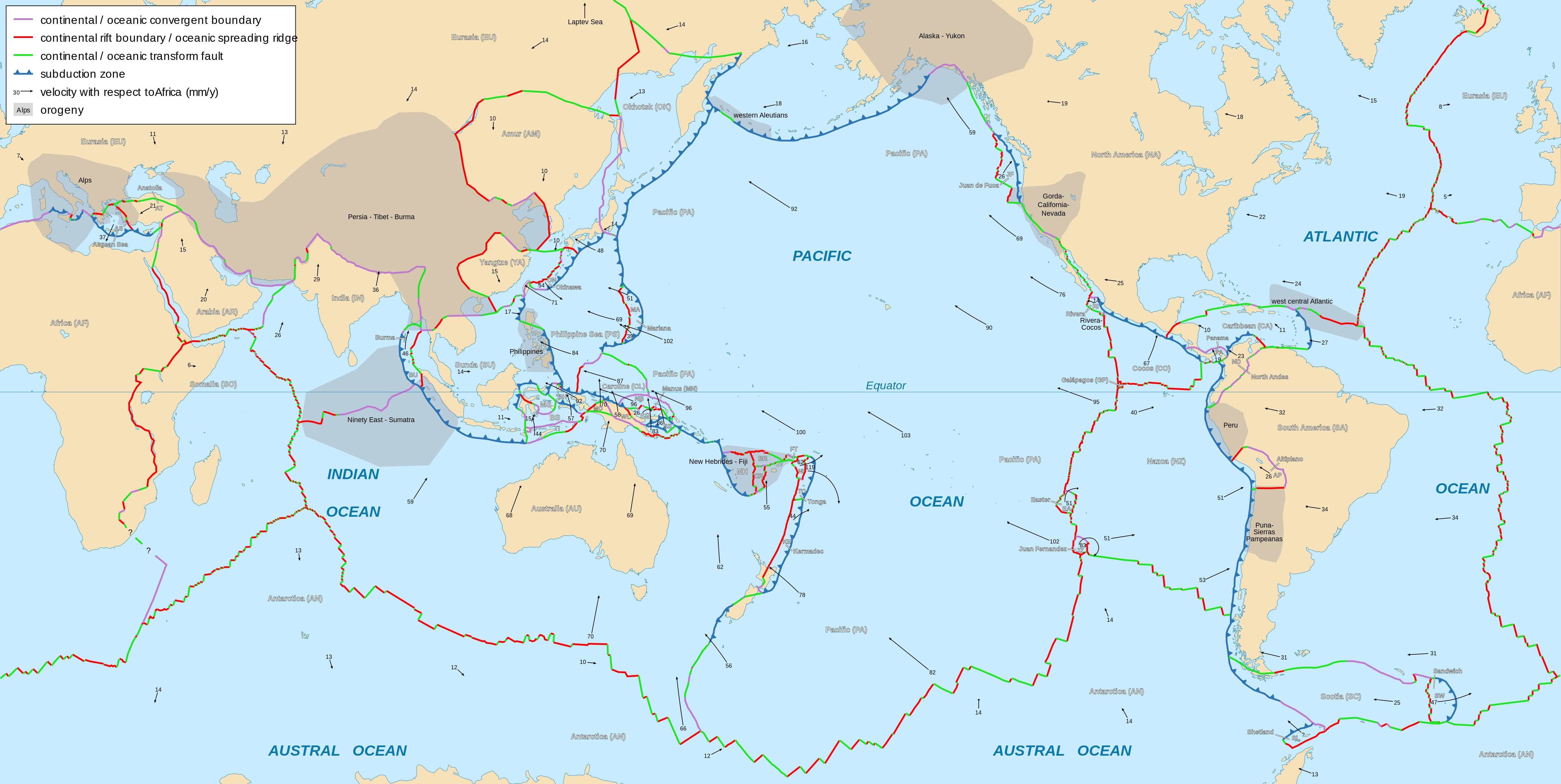
Revolution is a word usually reserved for significant political or social changes. Several of these idea revolutions forced scientists to re-examine their entire field, triggering a paradigm shift that shook up their conventionally held knowledge. Charles Darwin’s book on evolution, On the Origin of Species, published in 1859; Gregor Mendel’s discovery of the genetic principles of inheritance in 1866; and James Watson, Francis Crick, and Rosalind Franklin’s model for the structure of DNA in 1953 did that for biology. Albert Einstein’s relativity and quantum mechanics concepts in the early twentieth century did the same for Newtonian physics.
The concept of plate tectonics was just as revolutionary for geology. The theory of plate tectonics attributes the movement of massive sections of the Earth’s outer layers with creating earthquakes, mountains, and volcanoes. Many earth processes make more sense when viewed through the lens of plate tectonics. Because it is so important in understanding how the world works, plate tectonics is the first topic of discussion in this textbook.
2.1 Alfred Wegener’s Continental Drift Hypothesis
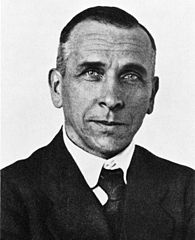
Alfred Wegener (1880-1930) was a German scientist who specialized in meteorology and climatology. His knack for questioning accepted ideas started in 1910 when he disagreed with the explanation that the Bering Land Bridge was formed by isostasy, and that similar land bridges once connected the continents. After reviewing the scientific literature, he published a hypothesis stating the continents were originally connected, and then drifted apart. While he did not have the precise mechanism worked out, his hypothesis was backed up by a long list of evidence.
2.1.1 Early Evidence for Continental Drift Hypothesis
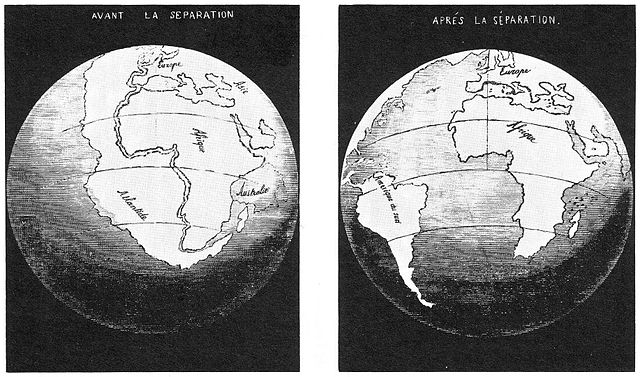
Wegener’s first piece of evidence was that the coastlines of some continents fit together like pieces of a jigsaw puzzle. People noticed the similarities in the coastlines of South America and Africa on the first world maps, and some suggested the continents had been ripped apart. Antonio Snider-Pellegrini did preliminary work on continental separation and matching fossils in 1858.
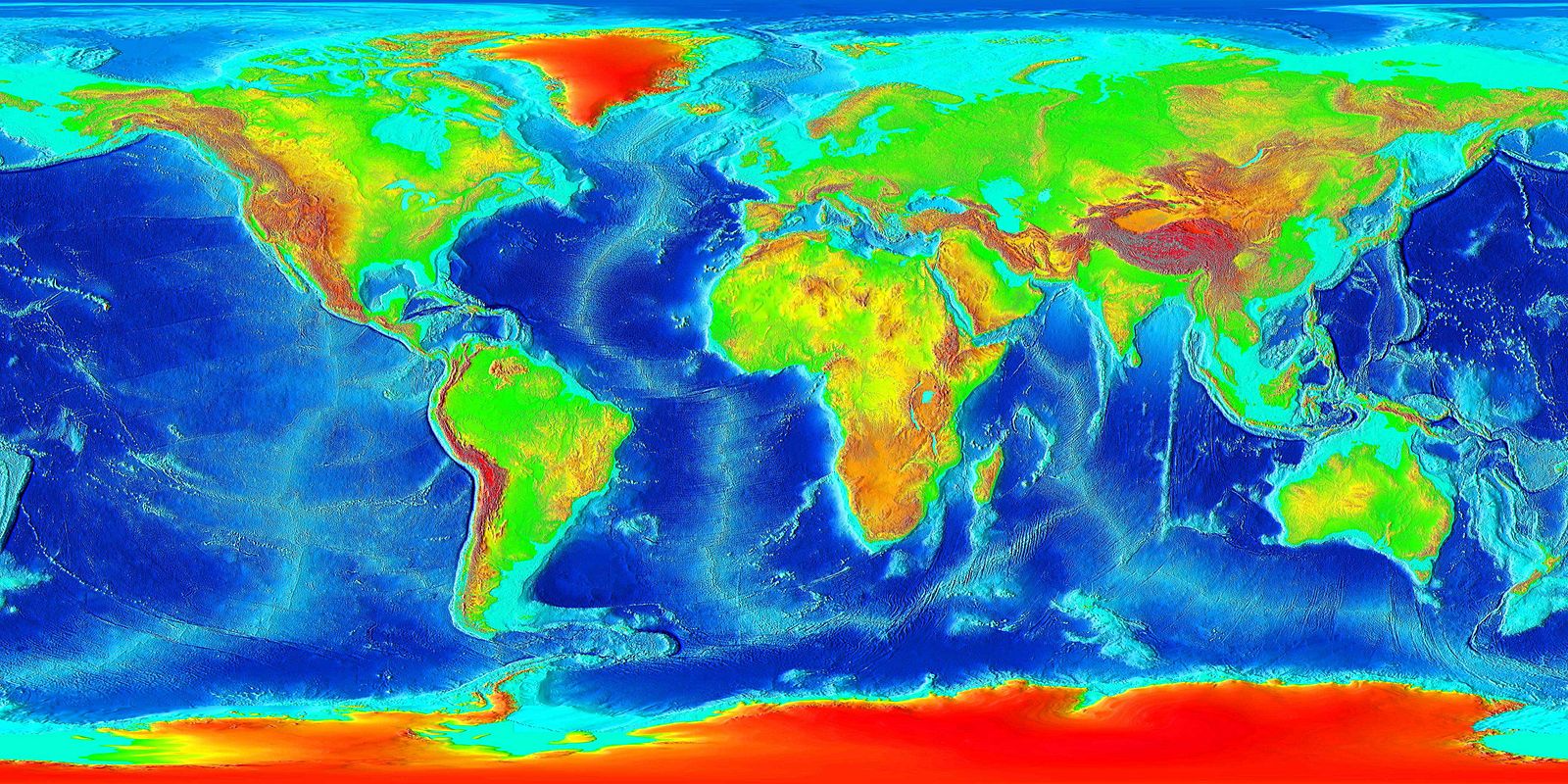
What Wegener did differently was synthesize a large amount of data in one place. He used true edges of the continents, based on the shapes of the continental shelves. This resulted in a better fit than previous efforts that traced the existing coastlines.
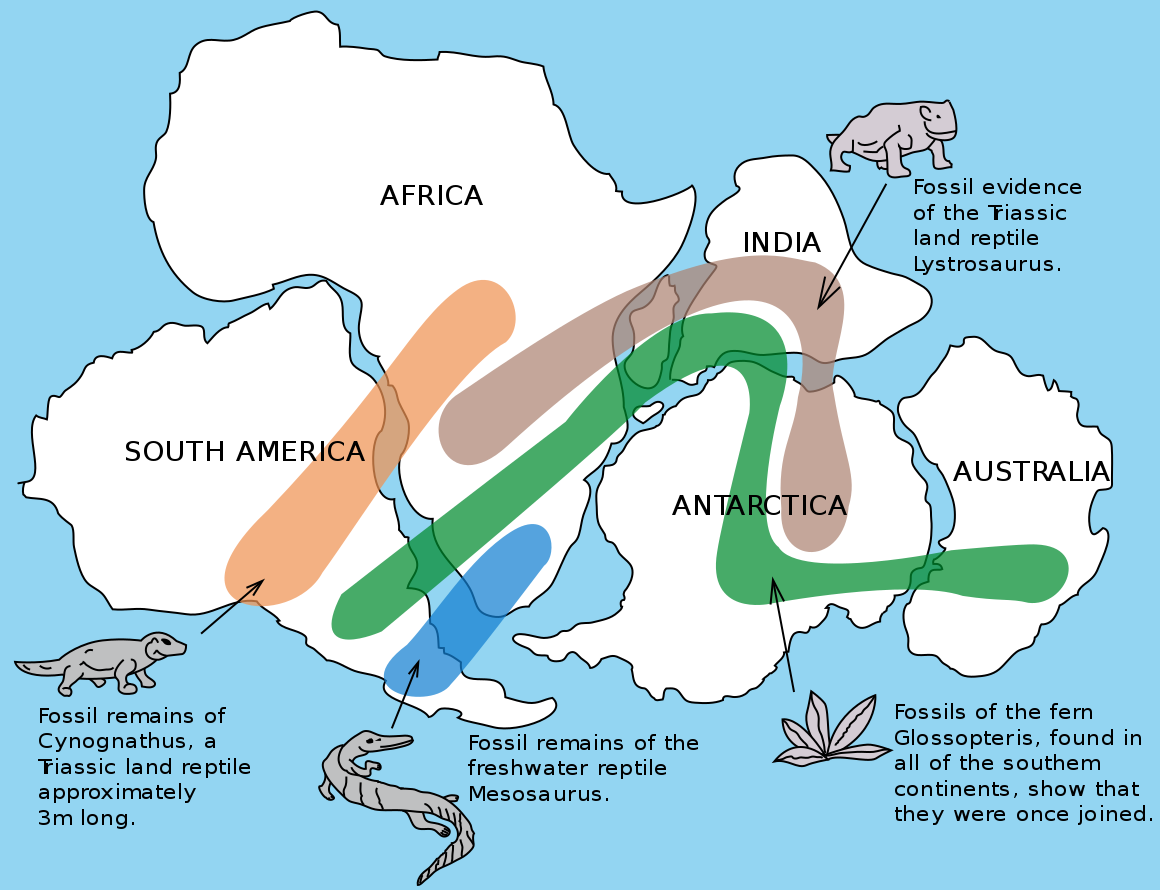
Wegener also compiled evidence by comparing similar rocks, mountains, fossils, and glacial formations across oceans. For example, the fossils of the primitive aquatic reptile Mesosaurus were found on the separate coastlines of Africa and South America. Fossils of another reptile, Lystrosaurus, were found on Africa, India, and Antarctica. He pointed out these were land-dwelling creatures could not have swum across an entire ocean.
Opponents of continental drift insisted trans-oceanic land bridges allowed animals and plants to move between continents. The land bridges eventually eroded away, leaving the continents permanently separated. The problem with this hypothesis is the improbability of a land bridge being tall and long enough to stretch across a broad, deep ocean.
More support for continental drift came from the puzzling evidence that glaciers once existed in normally very warm areas in southern Africa, India, Australia, and Arabia. These climate anomalies could not be explained by land bridges. Wegener found similar evidence when he discovered tropical plant fossils in the frozen region of the Arctic Circle. As Wegener collected more data, he realized the explanation that best fit all the climate, rock, and fossil observations involved moving continents.
2.1.2 Proposed Mechanism for Continental Drift
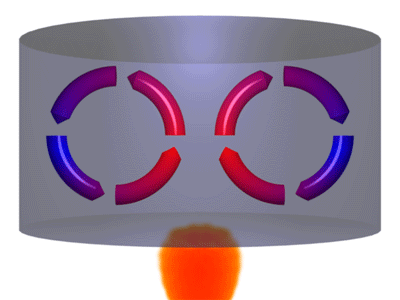
Wegener’s work was considered a fringe science theory for his entire life. One of the biggest flaws in his hypothesis was an inability to provide a mechanism for how the continents moved. Obviously, the continents did not appear to move, and changing the conservative minds of the scientific community would require exceptional evidence that supported a credible mechanism. Other pro-continental drift followers used expansion, contraction, or even the moon’s origin to explain how the continents moved. Wegener used centrifugal forces and precession, but this model was proven wrong. He also speculated about seafloor spreading, with hints of convection, but could not substantiate these proposals. As it turns out, current scientific knowledge reveals convection is one the major forces in driving plate movements, along with gravity and density.
2.1.3 Development of Plate Tectonic Theory
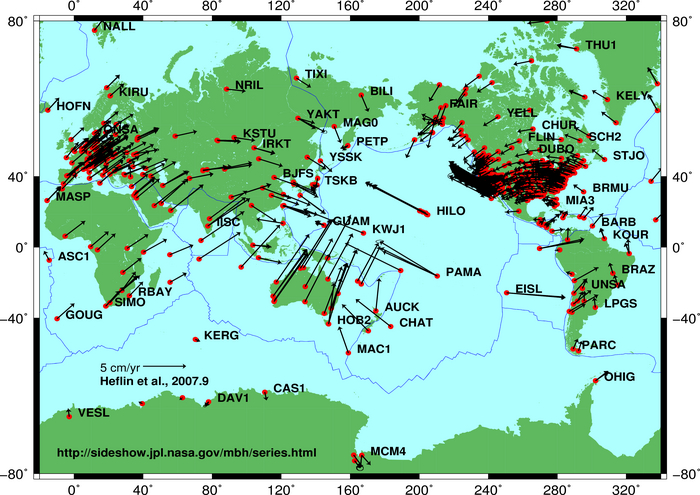
Wegener died in 1930 on an expedition in Greenland. Poorly respected in his lifetime, Wegener and his ideas about moving continents seemed destined to be lost in history as fringe science. However, in the 1950s, evidence started to trickle in that made continental drift a more viable idea. By the 1960s, scientists had amassed enough evidence to support the missing mechanism—namely, seafloor spreading—for Wegener’s hypothesis of continental drift to be accepted as the theory of plate tectonics. Ongoing GPS and earthquake data analyses continue to support this theory. The next section provides the pieces of evidence that helped transform one man’s wild notion into a scientific theory.
Mapping of the Ocean Floors
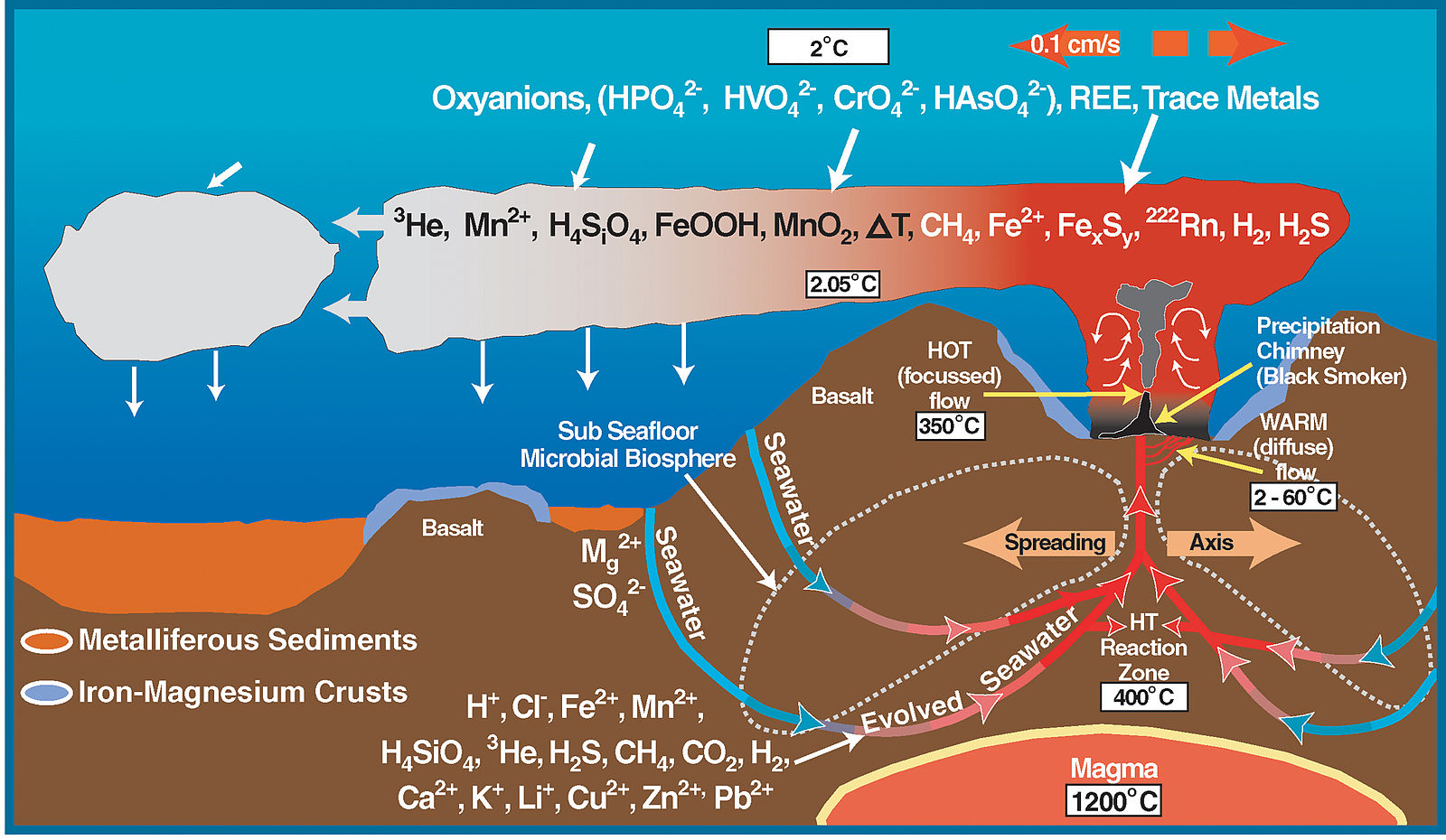
In 1947 researchers started using an adaptation of SONAR to map a region in the middle of the Atlantic Ocean with poorly-understood topographic and thermal properties. Using this information, Bruce Heezen and Marie Tharp created the first detailed map of the ocean floor to reveal the Mid-Atlantic Ridge, a basaltic mountain range that spanned the length of the Atlantic Ocean, with rock chemistry and dimensions unlike the mountains found on the continents. Initially scientists thought the ridge was part of a mechanism that explained the expanding Earth or ocean-basin growth hypotheses. In 1959, Harry Hess proposed the hypothesis of seafloor spreading—that the mid-ocean ridges represented tectonic plate factories, where new oceanic plate was issuing from these long volcanic ridges. Scientists later included transform faults perpendicular to the ridges to better account for varying rates of movement between the newly formed plates. When earthquake epicenters were discovered along the ridges, the idea that earthquakes were linked to plate movement took hold.

Video 2.1: Uncovering the secrets of the ocean floor.
If you are using an offline version of this text, access this YouTube video via the QR code.
Seafloor sediment, measured by dredging and drilling, provided another clue. Scientists once believed sediment accumulated on the ocean floors over a very long time in a static environment. When some studies showed less sediment than expected, these results were initially used to argue against continental movement. With more time, researchers discovered these thinner sediment layers were located close to mid-ocean ridges, indicating the ridges were younger than the surrounding ocean floor. This finding supported the idea that the sea floor was not fixed in one place.
Paleomagnetism
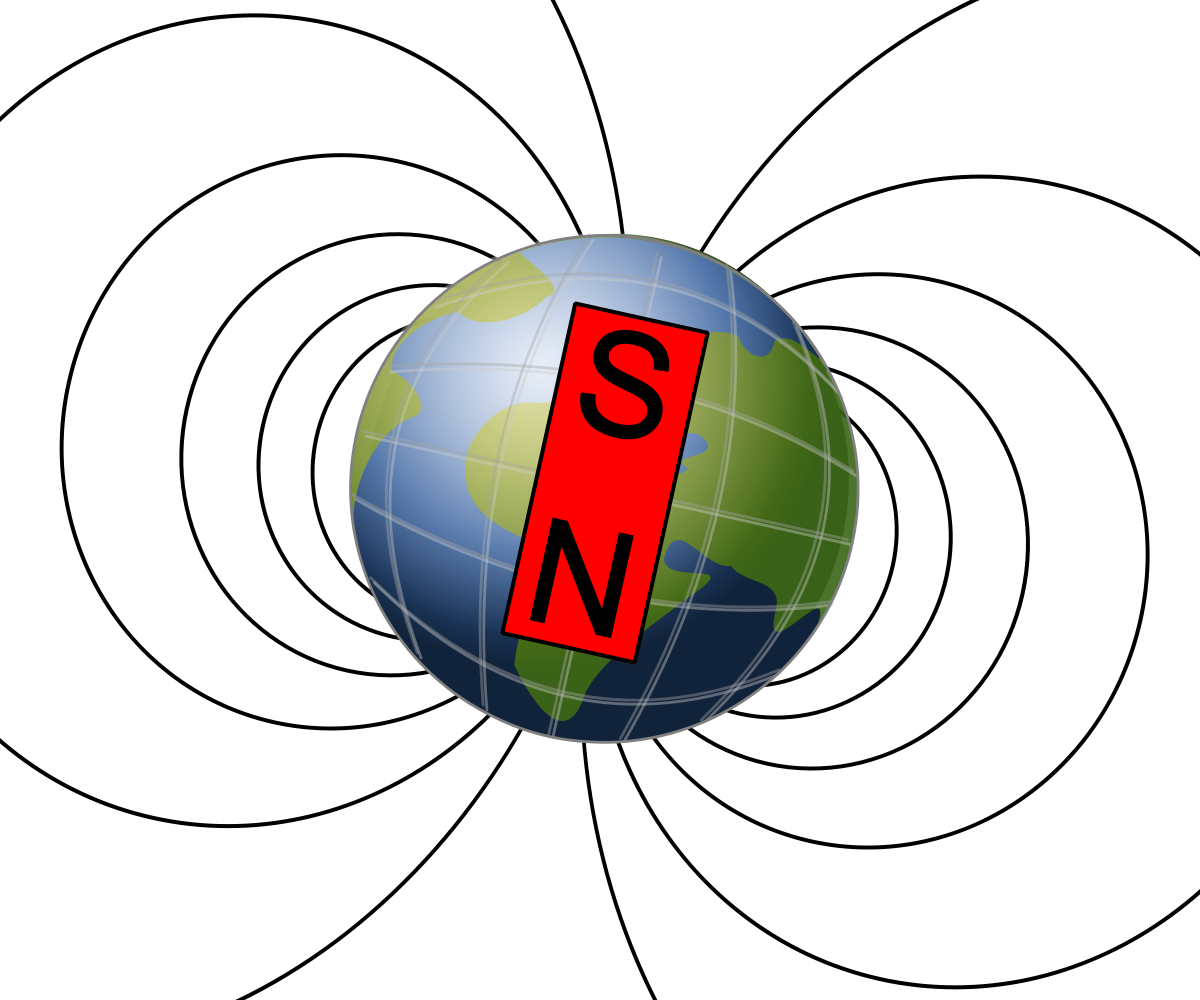
The seafloor was also mapped magnetically. Scientists had long known of strange magnetic anomalies that formed a striped pattern of symmetrical rows on both sides of mid-oceanic ridges. What made these features unusual was the north and south magnetic poles within each stripe was reversed in alternating rows. By 1963, Harry Hess and other scientists used these magnetic reversal patterns to support their model for seafloor spreading (see also Lawrence W. Morley).
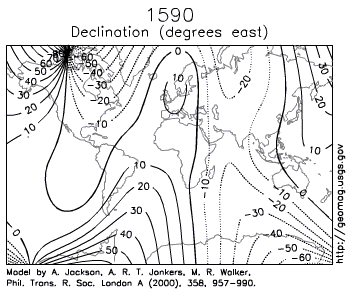
Paleomagnetism is the study of magnetic fields frozen within rocks, basically a fossilized compass. In fact, the first hard evidence to support plate motion came from paleomagnetism.
Igneous rocks containing magnetic minerals like magnetite typically provide the most useful data. In their liquid state as magma or lava, the magnetic poles of the minerals align themselves with the Earth’s magnetic field. When the rock cools and solidifies, this alignment is frozen into place, creating a permanent paleomagnetic record that includes magnetic inclination related to global latitude, and declination related to magnetic north.
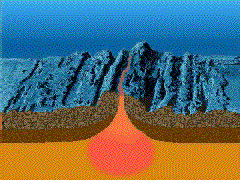
Scientists had noticed for some time the alignment of magnetic north in many rocks was nowhere close to the earth’s current magnetic north. Some explained this away are part of the normal movement of earth’s magnetic north pole. Eventually, scientists realized adding the idea of continental movement explained the data better than pole movement alone.
Wadati–Benioff Zones
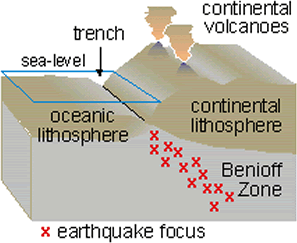
Around the same time mid-ocean ridges were being investigated, other scientists linked the creation of ocean trenches and island arcs to seismic activity and tectonic plate movement. Several independent research groups recognized earthquake epicenters traced the shapes of oceanic plates sinking into the mantle. These deep earthquake zones congregated in planes that started near the surface around ocean trenches and angled beneath the continents and island arcs. Today these earthquake zones called Wadati-Benioff zones.
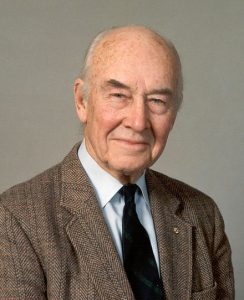
Based on the mounting evidence, the theory of plate tectonics continued to take shape. J. Tuzo Wilson was the first scientist to put the entire picture together by proposing that the opening and closing of the ocean basins. Before long, scientists proposed other models showing plates moving with respect to each other, with clear boundaries between them. Others started piecing together complicated histories of tectonic plate movement. The plate tectonic revolution had taken hold.

Complete this interactive activity to check your understanding.
If you are using an offline version of this text, access this interactive activity via the QR code.

Take this quiz to check your comprehension of this section.
If you are using an offline version of this text, access the quiz for section 2.1 via the QR code.
2.2 Layers of the Earth
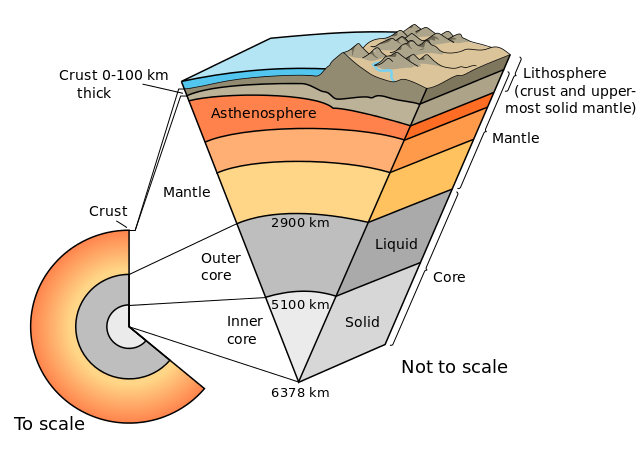
In order to understand the details of plate tectonics, it is essential to first understand the layers of the earth. Firsthand information about what is below the surface is very limited; most of what we know is pieced together from hypothetical models, and analyzing seismic wave data and meteorite materials. In general, the Earth can be divided into layers based on chemical composition and physical characteristics.
2.2.1 Chemical Layers
Certainly the earth is composed of a countless combination of elements. Regardless of what elements are involved two major factors—temperature and pressure—are responsible for creating three distinct chemical layers.
Crust
The outermost chemical layer and the one we currently reside on, is the crust. There are two types of crust. Continental crust has a relatively low density and composition similar to granite. Oceanic crust has a relatively high density, especially when cold and old, and composition similar to basalt. The surface levels of crust are relatively brittle. The deeper parts of the crust are subjected to higher temperatures and pressure, which makes them more ductile. Ductile materials are like soft plastics or putty, they move under force. Brittle materials are like solid glass or pottery, they break under force, especially when it is applied quickly. Earthquakes, generally occur in the upper crust and are caused by the rapid movement of relatively brittle materials.
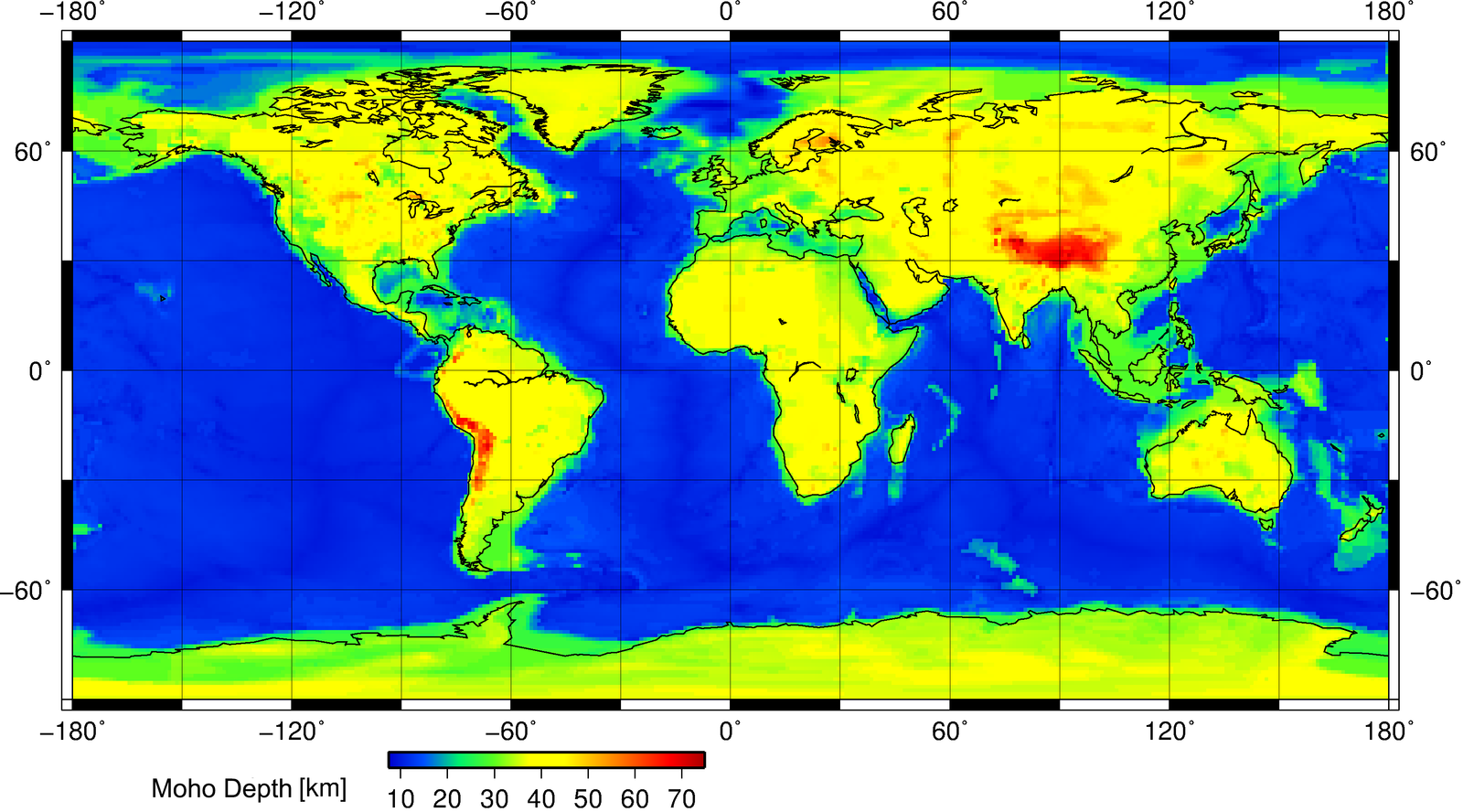
The base of the crust is characterized by a large increase in seismic velocity, which measures how fast earthquake waves travel through solid matter. Called the Mohorovičić Discontinuity, or Moho for short, this zone was discovered by Andrija Mohorovičić (pronounced mo-ho-ro-vee-cheech; audio pronunciation) in 1909 after studying earthquake wave paths in his native Croatia. The change in wave direction and speed is caused by dramatic chemical differences of the crust and mantle. Underneath the oceans, the Moho is found roughly 5 km below the ocean floor. Under the continents, it is located about 30-40 km below the surface. Near certain large mountain-building events known as orogenies, the continental Moho depth is doubled.
Mantle
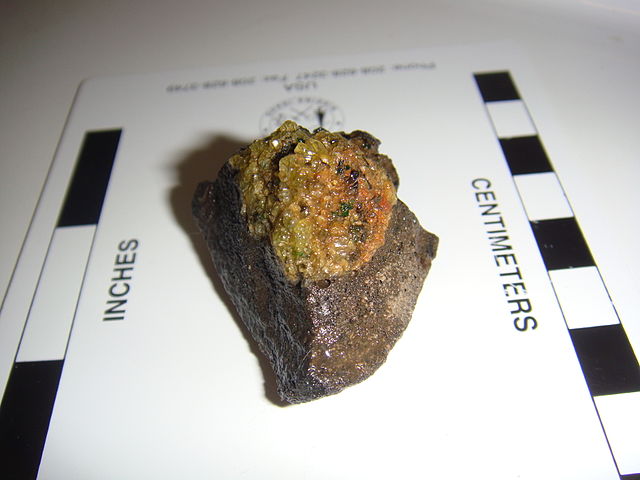
The mantle sits below the crust and above the core. It is the largest chemical layer by volume, extending from the base of the crust to a depth of about 2900 km. Most of what we know about the mantle comes from seismic wave analysis, though information is gathered by studying ophiolites and xenoliths. Ophiolites are pieces of mantle that have risen through the crust until they are exposed as part of the ocean floor. Xenoliths are carried within magma and brought to the Earth’s surface by volcanic eruptions. Most xenoliths are made of peridotite, an ultramafic class of igneous rock (see section 4.2 for explanation). Because of this, scientists hypothesize most of the mantle is made of peridotite.
Core

The core of the Earth, which has both liquid and solid layers, and consists mostly of iron, nickel, and possibly some oxygen. Scientists looking at seismic data first discovered this innermost chemical layer in 1906. Through a union of hypothetical modeling, astronomical insight, and hard seismic data, they concluded the core is mostly metallic iron. Scientists studying meteorites, which typically contain more iron than surface rocks, have proposed the earth was formed from meteoric material. They believe the liquid component of the core was created as the iron and nickel sank into the center of the planet, where it was liquefied by intense pressure.
2.2.2 Physical Layers
The Earth can also be broken down into five distinct physical layers based on how each layer responds to stress. While there is some overlap in the chemical and physical designations of layers, specifically the core–mantle boundary, there are significant differences between the two systems.
Lithosphere
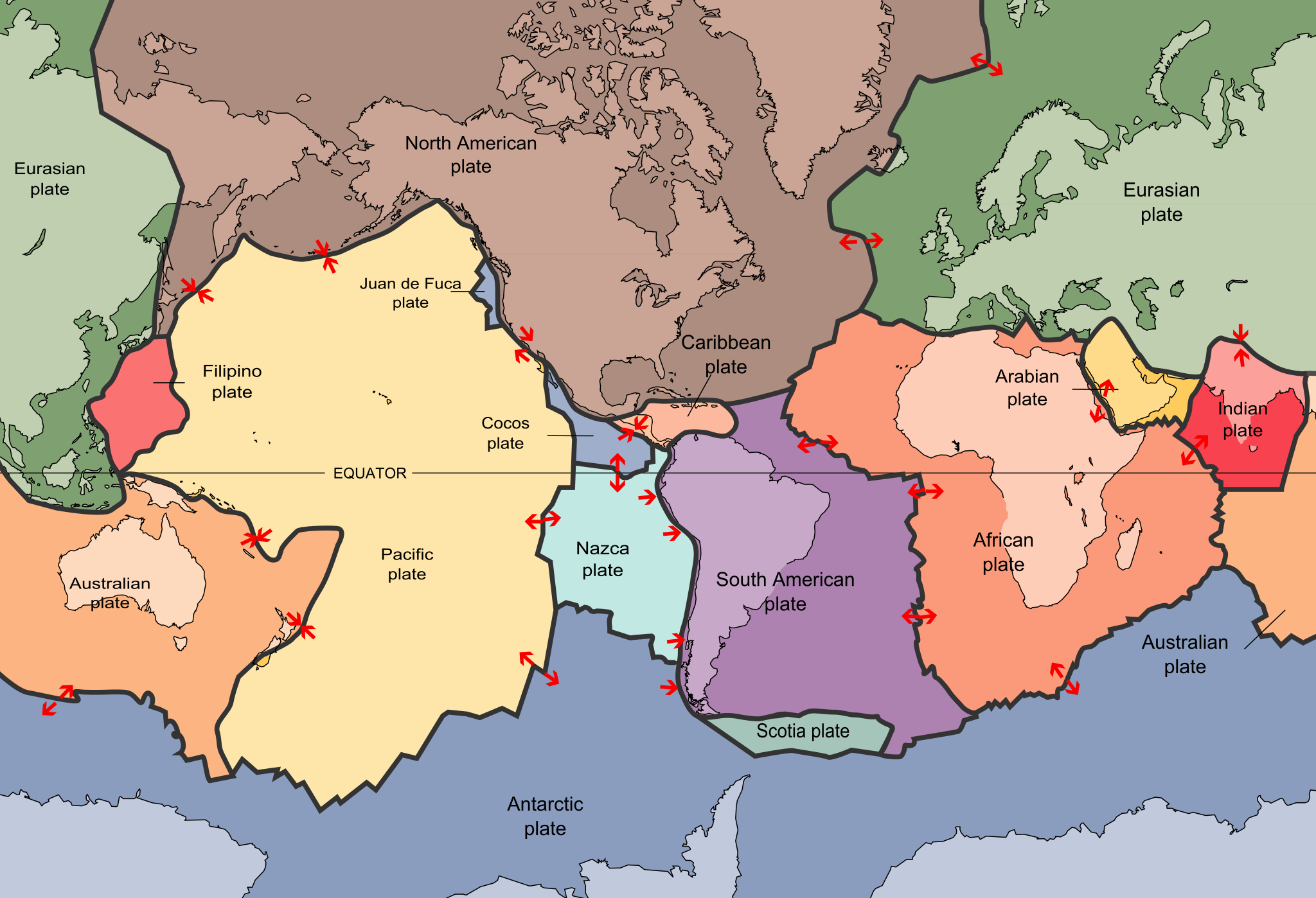
Lithos is Greek for stone, and the lithosphere is the outermost physical layer of the Earth. It is grouped into two types: oceanic and continental. Oceanic lithosphere is thin and relatively rigid. It ranges in thickness from nearly zero in new plates found around mid-ocean ridges, to an average of 140 km in most other locations. Continental lithosphere is generally thicker and considerably more plastic, especially at the deeper levels. Its thickness ranges from 40 to 280 km. The lithosphere is not continuous. It is broken into segments called plates. A plate boundary is where two plates meet and move relative to each other. Plate boundaries are where we see plate tectonics in action—mountain building, triggering earthquakes, and generating volcanic activity.
Asthenosphere
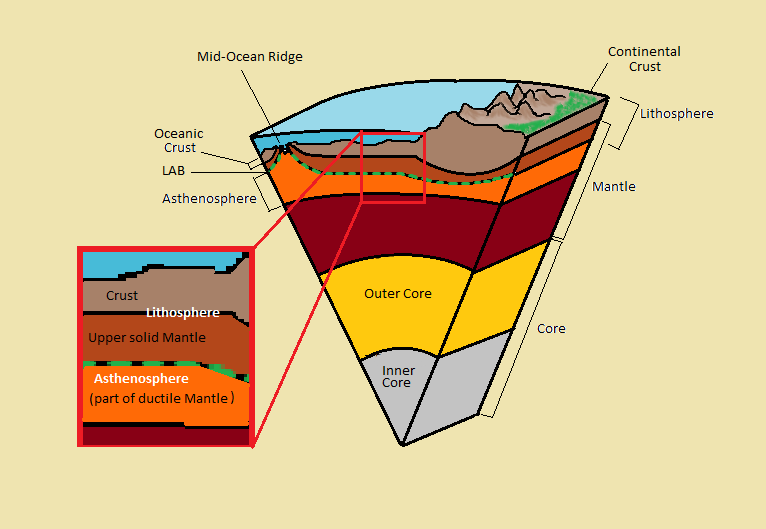
The asthenosphere is the layer below the lithosphere. Astheno- means lacking strength, and the most distinctive property of the asthenosphere is movement. Because it is mechanically weak, this layer moves and flows due to convection currents created by heat coming from the earth’s core cause. Unlike the lithosphere that consists of multiple plates, the asthenosphere is relatively unbroken. Scientists have determined this by analyzing seismic waves that pass through the layer. The depth of at which the asthenosphere is found is temperature-dependent. It tends to lie closer to the earth’s surface around mid-ocean ridges and much deeper underneath mountains and the centers of lithospheric plates.
Mesosphere
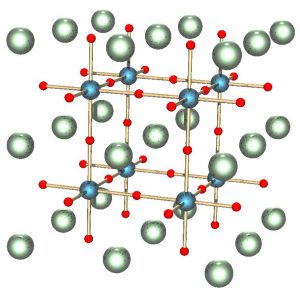
The mesosphere, sometimes known as the lower mantle, is more rigid and immobile than the asthenosphere. Located at a depth of approximately 410 and 660 km below the earth’s surface, the mesosphere is subjected to very high pressures and temperatures. These extreme conditions create a transition zone in the upper mesosphere where minerals continuously change into various forms, or pseudomorphs. Scientists identify this zone by changes in seismic velocity and sometimes physical barriers to movement. Below this transitional zone, the mesosphere is relatively uniform until it reaches the core.
Inner and Outer Core

The outer core is the only entirely liquid layer within the Earth. It starts at a depth of 2,890 km and extends to 5,150 km, making it about 2,300 km thick. In 1936, the Danish geophysicist Inge Lehmann analyzed seismic data and was the first to prove a solid inner core existed within a liquid outer core. The solid inner core is about 1,220 km thick, and the outer core is about 2,300 km thick.
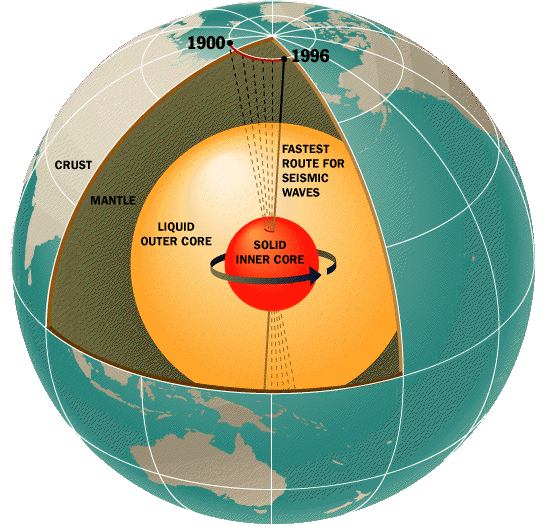
It seems like a contradiction that the hottest part of the Earth is solid, as the minerals making up the core should be liquified or vaporized at this temperature. Immense pressure keeps the minerals of the inner core in a solid phase. The inner core grows slowly from the lower outer core solidifying as heat escapes the interior of the Earth and is dispersed to the outer layers.
The earth’s liquid outer core is critically important in maintaining a breathable atmosphere and other environmental conditions favorable for life. Scientists believe the earth’s magnetic field is generated by the circulation of molten iron and nickel within the outer core. If the outer core were to stop circulating or become solid, the loss of the magnetic field would result in Earth getting stripped of life-supporting gases and water. This is what happened, and continues to happen, on Mars.

Complete this interactive activity to check your understanding.
If you are using an offline version of this text, access this interactive activity via the QR code.
2.2.3 Plate Tectonic Boundaries
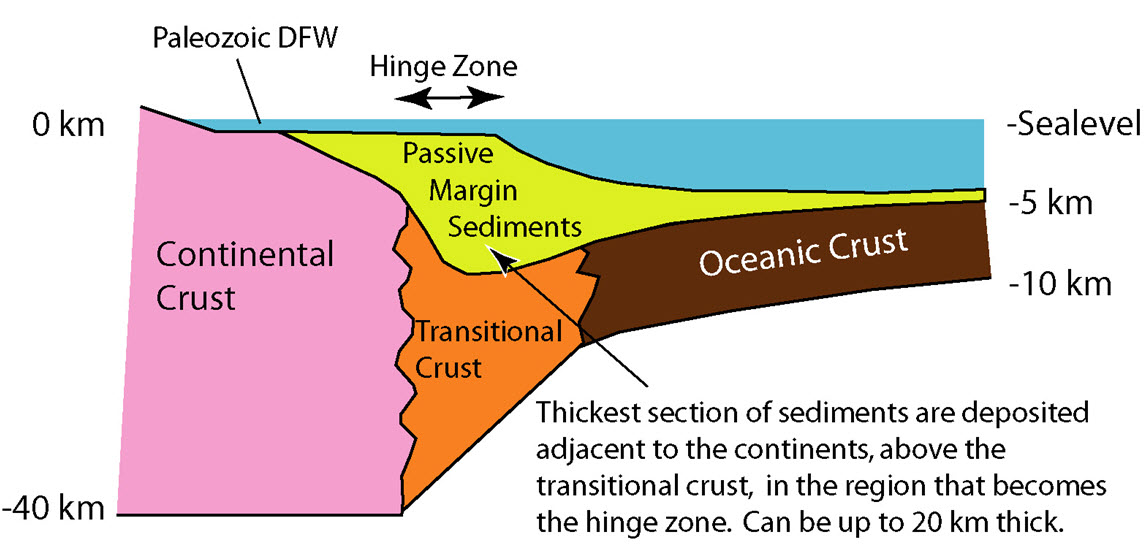
At passive margins the plates don’t move—the continental lithosphere transitions into oceanic lithosphere and forms plates made of both types. A tectonic plate may be made of both oceanic and continental lithosphere connected by a passive margin. North and South America’s eastern coastlines are examples of passive margins. Active margins are places where the oceanic and continental lithospheric tectonic plates meet and move relative to each other, such as the western coasts of North and South America. This movement is caused by frictional drag created between the plates and differences in plate densities. The majority of mountain-building events, earthquake activity and active volcanism on the Earth’s surface can be attributed to tectonic plate movement at active margins.
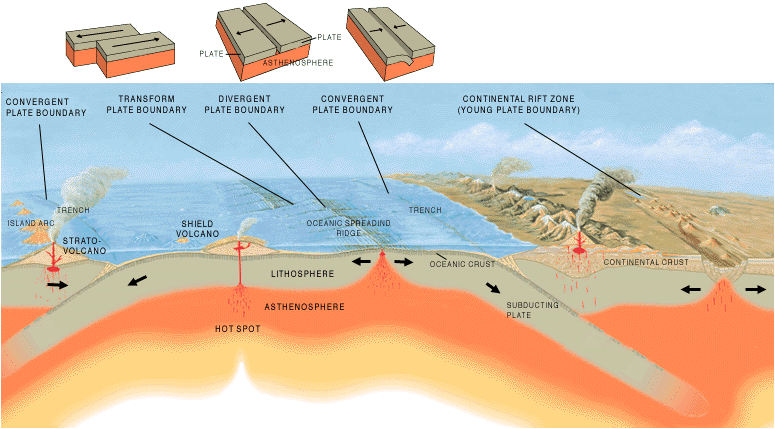
In a simplified model, there are three categories of tectonic plate boundaries. Convergent boundaries are places where plates move toward each other. At divergent boundaries, the plates move apart. At transform boundaries, the plates slide past each other.

Take this quiz to check your comprehension of this section.
If you are using an offline version of this text, access the quiz for section 2.2 via the QR code.
2.3 Convergent Boundaries
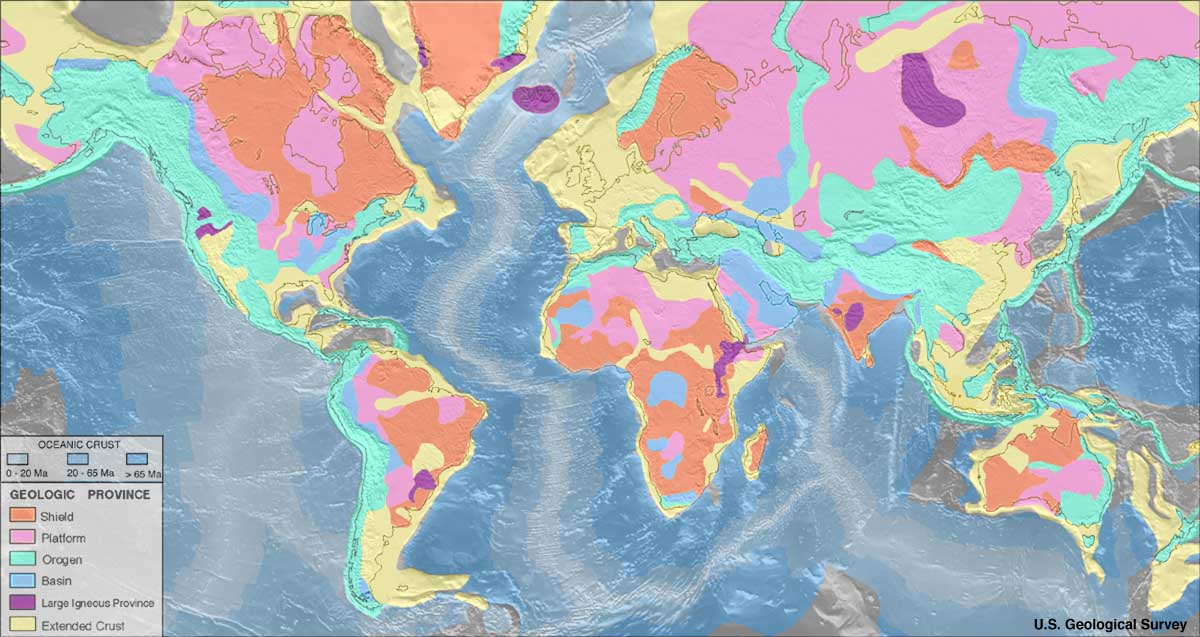
Convergent boundaries, also called destructive boundaries, are places where two or more plates move toward each other. Convergent boundary movement is divided into two types, subduction and collision, depending on the density of the involved plates. Continental lithosphere is of lower density and thus more buoyant than the underlying asthenosphere. Oceanic lithosphere is more dense than continental lithosphere, and, when old and cold, may even be more dense than asthenosphere.
When plates of different densities converge, the higher density plate is pushed beneath the more buoyant plate in a process called subduction. When continental plates converge without subduction occurring, this process is called collision.
2.3.1. Subduction
Subduction occurs when a dense oceanic plate meets a more buoyant plate, like a continental plate or warmer/younger oceanic plate, and descends into the mantle. The worldwide average rate of oceanic plate subduction is 25 miles per million years, about a half-inch per year. As an oceanic plate descends, it pulls the ocean floor down into a trench. These trenches can be more than twice as deep as the average depth of the adjacent ocean basin, which is usually three to four km. The Mariana Trench, for example, approaches a staggering 11 km.
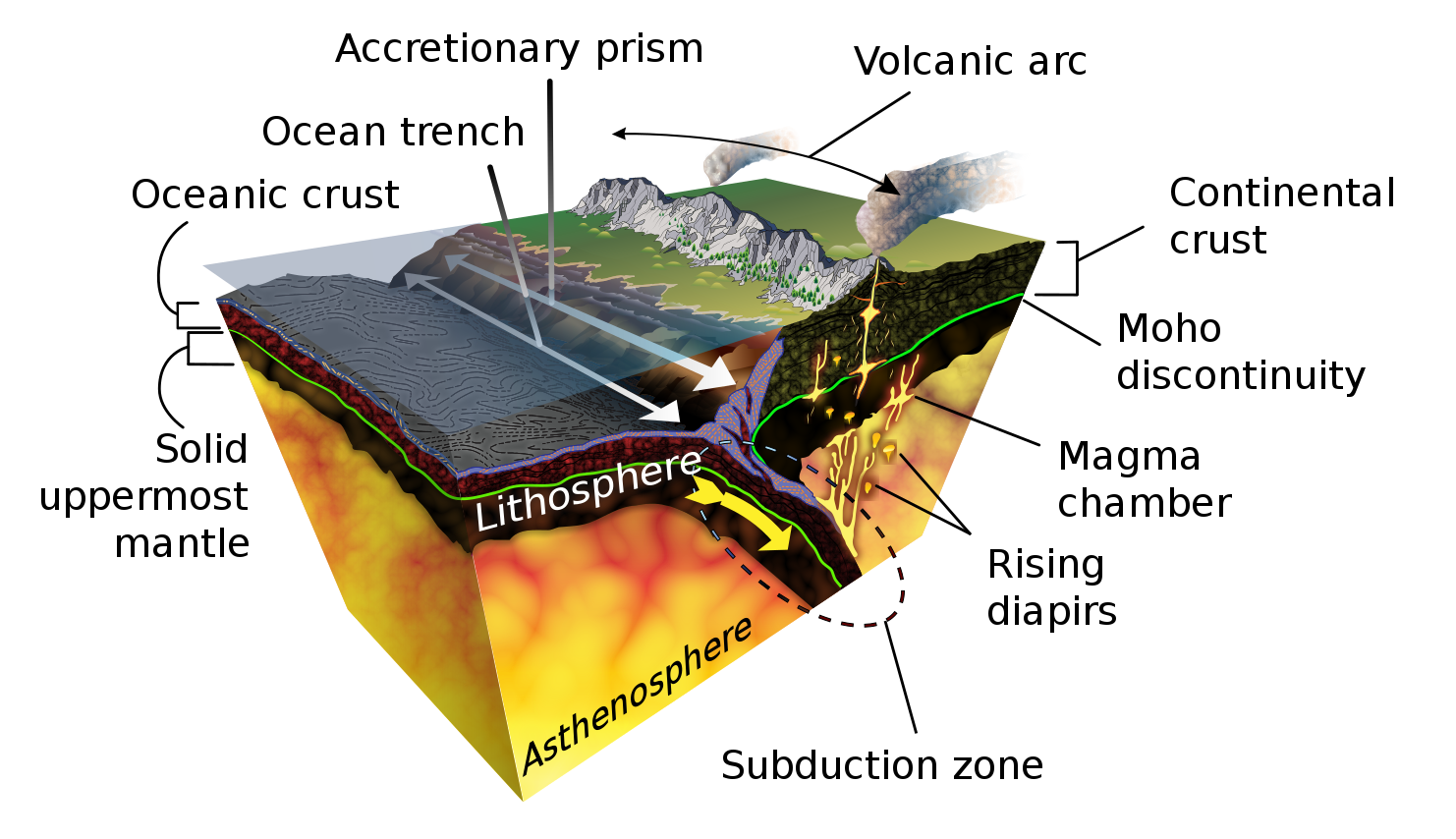
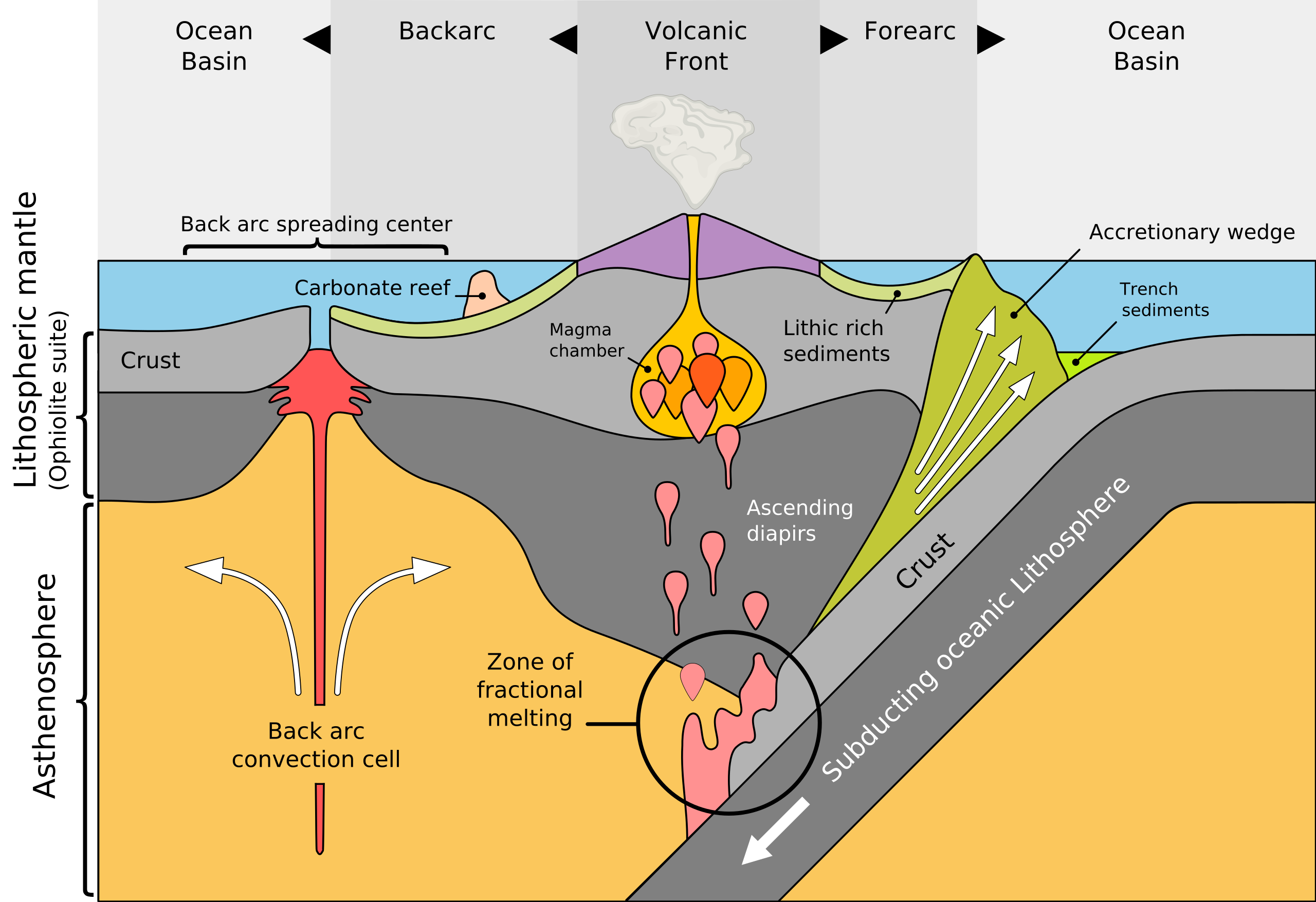
Within the trench, ocean floor sediments are scraped together and compressed between the subducting and overriding plates. This feature is called the accretionary wedge, mélange, or accretionary prism. Fragments of continental material, including microcontinents, riding atop the subducting plate may become sutured to the accretionary wedge and accumulate into a large area of land called a terrane. Vast portions of California are comprised of accreted terranes.
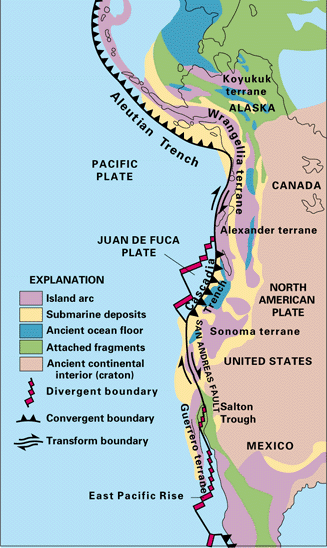
When the subducting oceanic plate, or slab, sinks into the mantle, the immense heat and pressure pushes volatile materials like water and carbon dioxide into an area below the continental plate and above the descending plate called the mantle wedge. The volatiles are released mostly by hydrated minerals that revert to non-hydrated minerals in these higher temperature and pressure conditions. When mixed with asthenospheric material above the plate, the volatile lower the melting point of the mantle wedge, and through a process called flux melting it becomes liquid magma. The molten magma is more buoyant than the lithospheric plate above it and migrates to the Earth’s surface where it emerges as volcanism. The resulting volcanoes frequently appear as curved mountain chains, volcanic arcs, due to the curvature of the earth. Both oceanic and continental plates can contain volcanic arcs.
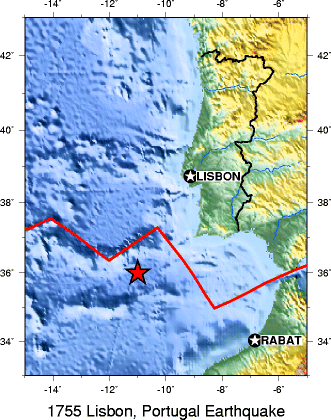
How subduction is initiated is still a matter of scientific debate. It is generally accepted that subduction zones start as passive margins, where oceanic and continental plates come together, and then gravity initiates subduction and converts the passive margin into an active one. One hypothesis is gravity pulls the denser oceanic plate down or the plate can start to flow ductility at a low angle. Scientists seeking to answer this question have collected evidence that suggests a new subduction zone is forming off the coast of Portugal. Some scientists have proposed large earthquakes like the 1755 Lisbon earthquake may even have something to do with this process of creating a subduction zone, although the evidence is not definitive. Another hypothesis proposes subduction happens at transform boundaries involving plates of different densities.
Some plate boundaries look like they should be active, but show no evidence of subduction. The oceanic lithospheric plates on either side of the Atlantic Ocean for example, are denser than the underlying asthenosphere and are not subducting beneath the continental plates. One hypothesis is the bond holding the oceanic and continental plates together is stronger than the downwards force created by the difference in plate densities.
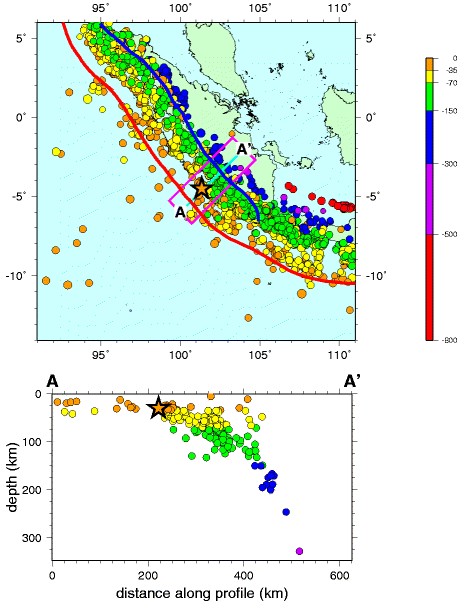
Subduction zones are known for having the largest earthquakes and tsunamis; they are the only places with fault surfaces large enough to create magnitude-9 earthquakes. These subduction-zone earthquakes not only are very large, but also are very deep. When a subducting slab becomes stuck and cannot descend, a massive amount of energy builds up between the stuck plates. If this energy is not gradually dispersed, it may force the plates to suddenly release along several hundred kilometers of the subduction zone. Because subduction-zone faults are located on the ocean floor, this massive amount of movement can generate giant tsunamis such as those that followed the 2004 Indian Ocean Earthquake and 2011 Tōhoku Earthquake in Japan.
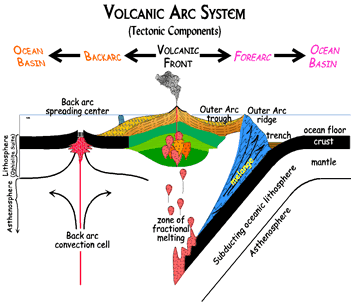
All subduction zones have a forearc basin, a feature of the overriding plate found between the volcanic arc and oceanic trench. The forearc basin experiences a lot of faulting and deformation activity, particularly within the accretionary wedge.
In some subduction zones, tensional forces working on the continental plate create a backarc basin on the interior side of the volcanic arc. Some scientists have proposed a subduction mechanism called oceanic slab rollback creates extension faults in the overriding plates. In this model, the descending oceanic slab does not slide directly under the overriding plate but instead rolls back, pulling the overlying plate seaward. The continental plate behind the volcanic arc gets stretched like pizza dough until the surface cracks and collapses to form a backarc basin. If the extension activity is extensive and deep enough, a backarc basin can develop into a continental rifting zone. These continental divergent boundaries may be less symmetrical than their mid-ocean ridge counterparts.
In places where numerous young buoyant oceanic plates are converging and subducting at a relatively high velocity, they may force the overlying continental plate to buckle and crack. This is called back-arc faulting. Extensional back-arc faults pull rocks and chunks of plates apart. Compressional back-arc faults, also known as thrust faults, push them together.
The dual spines of the Andes Mountain range include a example of compressional thrust faulting. The western spine is part of a volcanic arc. Thrust faults have deformed the non-volcanic eastern spine, pushing rocks and pieces of continental plate on top of each other.
There are two styles of thrust fault deformation: thin-skinned faults that occur in superficial rocks lying on top of the continental plate and thick-skinned faults that reach deeper into the crust. The Sevier Orogeny in the western U.S. is a notable thin-skinned type of deformation created during the Cretaceous Period. The Laramide Orogeny, a thick-skinned type of deformation, occurred near the end of and slightly after the Sevier Orogeny in the same region.
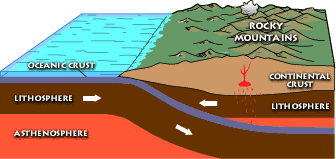
Flat-slab, or shallow, subduction caused the Laramide Orogeny. When the descending slab subducts at a low angle, there is more contact between the slab and the overlying continental plate than in a typical subduction zone. The shallowly-subducting slab pushes against the overriding plate and creates an area of deformation on the overriding plate many kilometers away from the subduction zone.
Oceanic–Continental Subduction
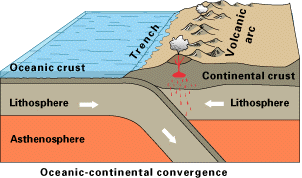
Oceanic-continental subduction occurs when an oceanic plate dives below a continental plate. This convergent boundary has a trench and mantle wedge and frequently, a volcanic arc. Well-known examples of continental volcanic arcs are the Cascade Mountains in the Pacific Northwest and western Andes Mountains in South America.
Oceanic–Oceanic Subduction
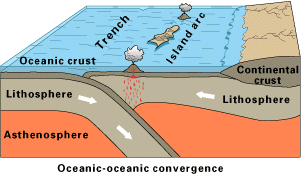
The boundaries of oceanic-oceanic subduction zones show very different activity from those involving oceanic–continental plates. Since both plates are made of oceanic lithosphere, it is usually the older plate that subducts because it is colder and denser. The volcanism on the overlying oceanic plate may remain hidden underwater.. If the volcanoes rise high enough the reach the ocean surface, the chain of volcanism forms an island arc. Examples of these island arcs include the Aleutian Islands in the northern Pacific Ocean, Lesser Antilles in the Caribbean Sea, and numerous island chains scattered throughout the western Pacific Ocean.
2.3.2. Collisions
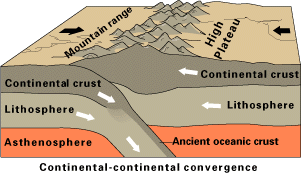
When continental plates converge, during the closing of an ocean basin for example, subduction is not possible between the equally buoyant plates. Instead of one plate descending beneath another, the two masses of continental lithosphere slam together in a process known as collision. Without subduction, there is no magma formation and no volcanism. Collision zones are characterized by tall, non-volcanic mountains; a broad zone of frequent, large earthquakes; and very little volcanism.
When oceanic crust connected by a passive margin to continental crust completely subducts beneath a continent, an ocean basin closes, and continental collision begins. Eventually, as ocean basins close, continents join together to form a massive accumulation of continents called a supercontinent, a process that has taken place in ~500 million year old cycles over earth’s history.
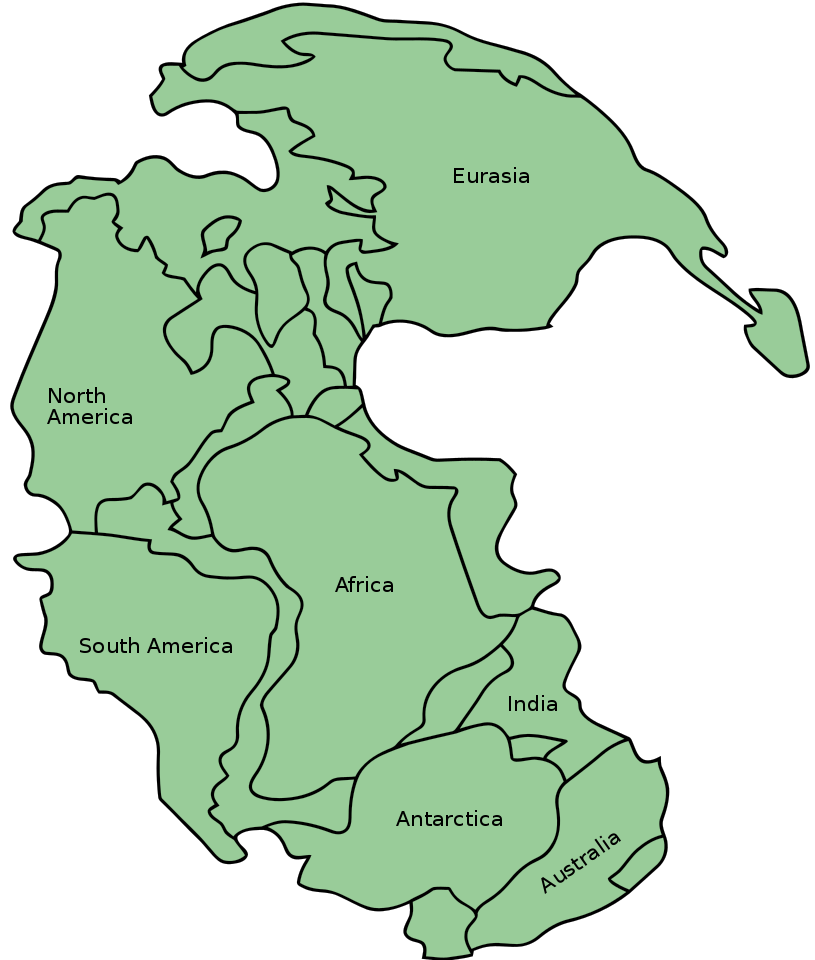
The process of collision created Pangea, the supercontinent envisioned by Wegener as the key component of his continental drift hypothesis. Geologists now have evidence that continental plates have been continuously converging into supercontinents and splitting into smaller basin-separated continents throughout Earth’s existence, calling this process the supercontinent cycle, a process that takes place in approximately 500 million years. For example, they estimate Pangea began separating 200 million years ago. Pangea was preceded by an earlier supercontinents, one of which being Rodinia, which existed 1.1 billion years ago and started breaking apart 800 million to 600 million years ago.
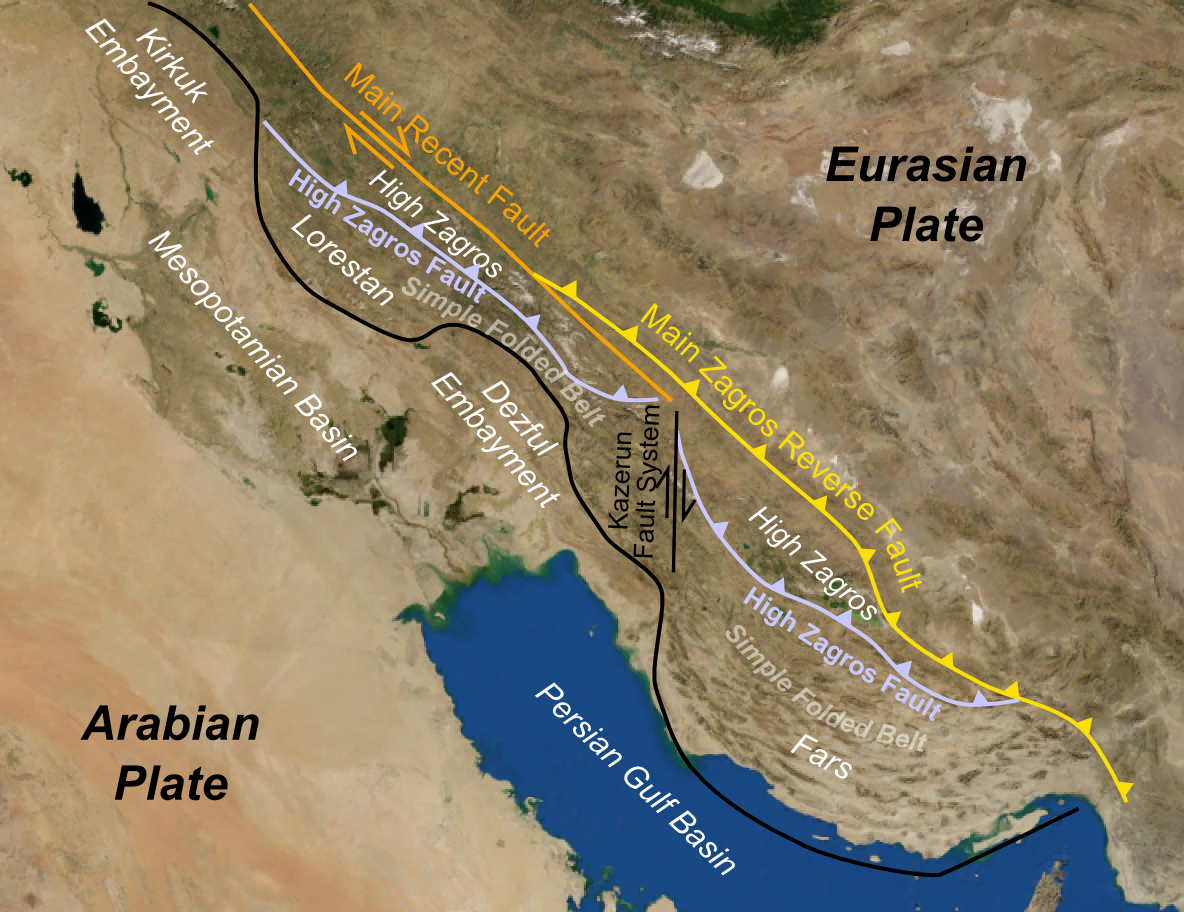
A foreland basin is a feature that develops near mountain belts, as the combined mass of the mountains forms a depression in the lithospheric plate. While foreland basins may occur at subduction zones, they are most commonly found at collision boundaries. The Persian Gulf is possibly the best modern example, created entirely by the weight of the nearby Zagros Mountains.
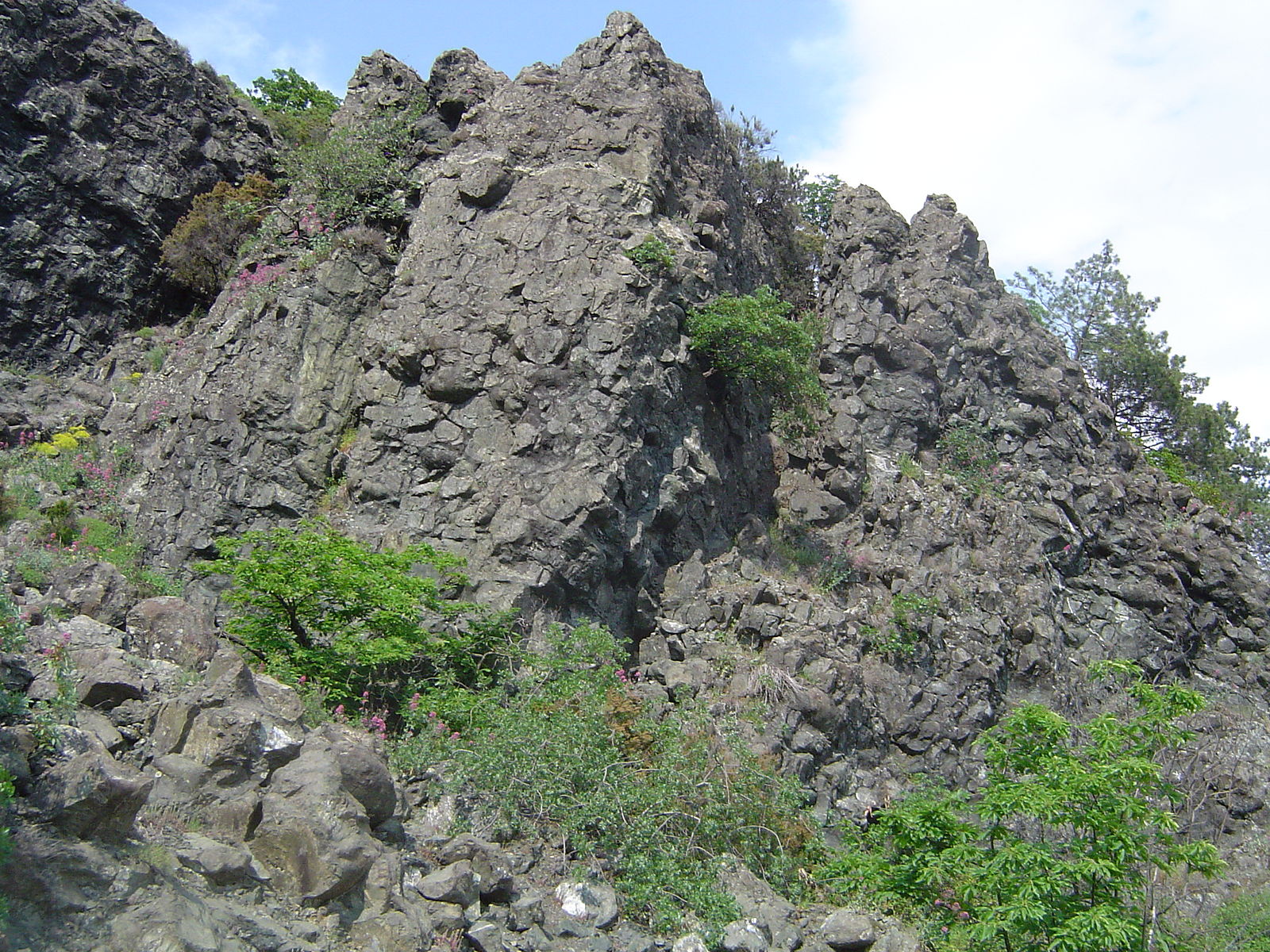
If continental and oceanic lithosphere are fused on the same plate, it can partially subduct but its buoyancy prevents it from fully descending. In very rare cases, part of a continental plate may become trapped beneath a descending oceanic plate in a process called obduction. When a portion of the continental crust is driven down into the subduction zone, due to its buoyancy it returns to the surface relatively quickly.
As pieces of the continental lithosphere break loose and migrate upward through the obduction zone, they bring along bits of the mantle and ocean floor and amend them on top of the continental plate. Rocks composed of this mantle and ocean-floor material are called ophiolites and they provide valuable information about the composition of the mantle.
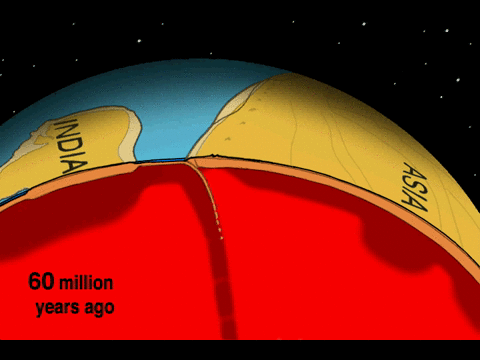
The area of collision-zone deformation and seismic activity usually covers a broader area because continental lithosphere is plastic and malleable. Unlike subduction-zone earthquakes, which tend to be located along a narrow swath near the convergent boundary, collision-zone earthquakes may occur hundreds of kilometers from the boundary between the plates.
The Eurasian continent has many examples of collision-zone deformations covering vast areas. The Pyrenees mountains begin in the Iberian Peninsula and cross into France. Also, there are the Alps stretching from Italy to central Europe; the Zagros mountains from Arabia to Iran; and Himalaya mountains from the Indian subcontinent to central Asia.

Take this quiz to check your comprehension of this section.
If you are using an offline version of this text, access the quiz for section 2.3 via the QR code.
2.4 Divergent Boundaries
At divergent boundaries, sometimes called constructive boundaries, lithospheric plates move away from each other. There are two types of divergent boundaries, categorized by where they occur: continental rift zones and mid-ocean ridges. Continental rift zones occur in weak spots in the continental lithospheric plate. A mid-ocean ridge usually originates in a continental plate as a rift zone that expands to the point of splitting the plate apart, with seawater filling in the gap. The separate pieces continue to drift apart and become individual continents. This process is known as rift-to-drift.
2.4.1. Continental Rifting
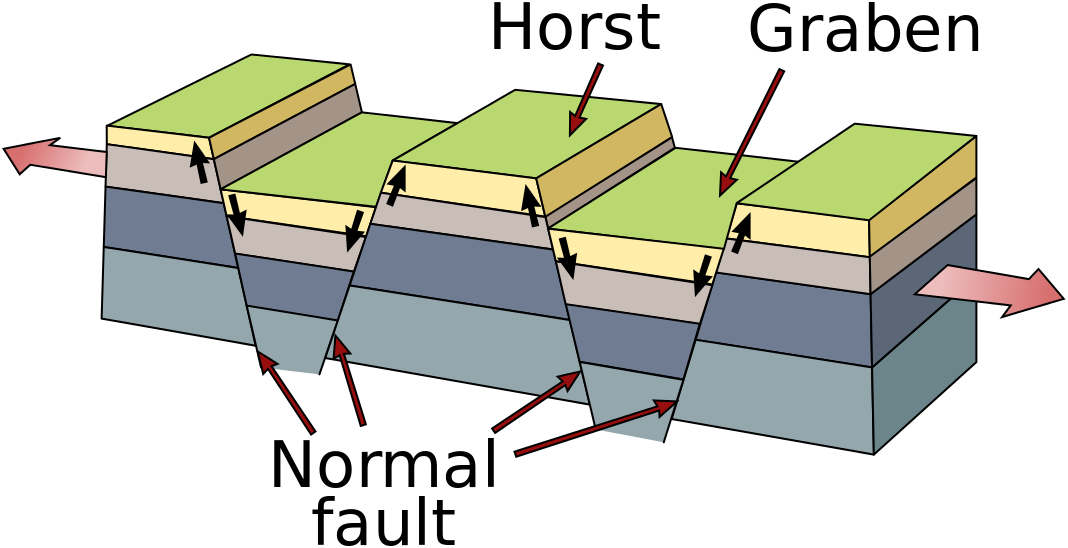
In places where the continental plates are very thick, they reflect so much heat back into the mantle it develops strong convection currents that push super-heated mantle material up against the overlying plate, softening it. Tensional forces created by this convective upwelling begin to pull the weakened plate apart. As it stretches, it becomes thinner and develops deep cracks called extension or normal faults. Eventually plate sections located between large faults drop into deep depressions known as rift valleys, which often contain keystone-shaped blocks of down-dropped crust known as grabens. The shoulders of these grabens are called horsts. If only one side of a section drops, it is called a half-graben. Depending on the conditions, rifts can grow into very large lakes and even oceans.

While seemingly occurring at random, rifting is dictated by two factors. Rifting does not occur in continents with older and more stable interiors, known as cratons. When continental rifting does occur, the break-up pattern resembles the seams of a soccer ball, also called a truncated icosahedron. This is the most common surface-fracture pattern to develop on an evenly expanding sphere because it uses the least amount of energy.
Using the soccer ball model, rifting tends to lengthen and expand along a particular seam while fizzling out in the other directions. These seams with little or no tectonic activity are called failed rift arms. A failed rift arm is still a weak spot in the continental plate; even without the presence of active extension faults, it may develop into a called an aulacogen. One example of a failed rift arm is the Mississippi Valley Embayment, a depression through which the upper end of the Mississippi River flows. Occasionally connected rift arms do develop concurrently, creating multiple boundaries of active rifting. In places where the rift arms do not fail, for example the Afar Triangle, three divergent boundaries can develop near each other forming a triple junction.

Rifts come in two types: narrow and broad. Narrow rifts are characterized by a high density of highly active divergent boundaries. The East African Rift Zone, where the horn of Africa is pulling away from the mainland, is an excellent example of an active narrow rift. Lake Baikal in Russia is another. Broad rifts also have numerous fault zones, but they are distributed over wide areas of deformation. The Basin and Range region located in the western United States is a type of broad rift. The Wasatch Fault, which also created the Wasatch Mountain Range in the state of Utah, forms the eastern divergent boundary of this broad rift (animation 1 and animation 2).
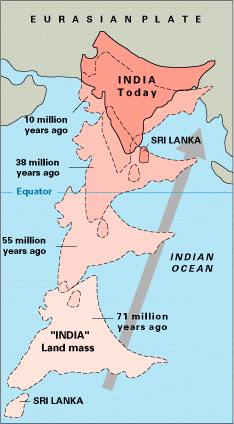
Rifts have earthquakes, although not of the magnitude and frequency of other boundaries. They may also exhibit volcanism. Unlike the flux-melted magma found in subduction zones, rift-zone magma is created by decompression melting. As the continental plates are pulled apart, they create a region of low pressure that melts the lithosphere and draws it upwards. When this molten magma reaches the weakened and fault-riddled rift zone, it migrates to surface by breaking through the plate or escaping via an open fault. Examples of young rift volcanoes dot the Basin and Range region in the United States. Rift-zone activity is responsible for generating some unique volcanism, such as the Ol Doinyo Lengai in Tanzania. This volcano erupts lava consisting largely of carbonatite, a relatively cold, liquid carbonate mineral.
2.4.2. Mid-ocean Ridges
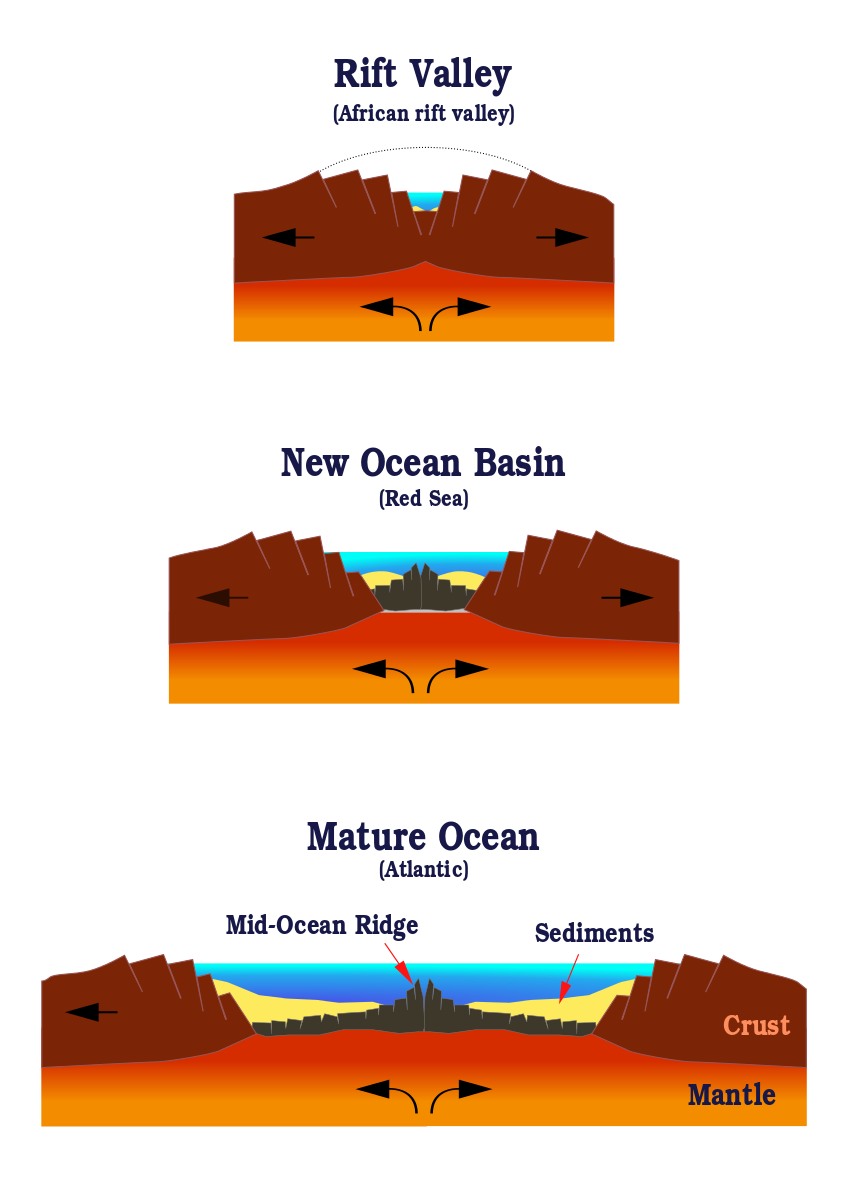
As rifting and volcanic activity progress, the continental lithosphere becomes more mafic (see chapter 4) and thinner, with the eventual result transforming the plate under the rifting area into oceanic lithosphere. This is the process that gives birth to a new ocean, much like the narrow Red Sea emerged with the movement of Arabia away from Africa. As the oceanic lithosphere continues to diverge, a mid-ocean ridge is formed.
Mid-ocean ridges, also known as spreading centers, have several distinctive features. They are the only places on earth that create new oceanic lithosphere. Decompression melting in the rift zone changes asthenosphere material into new lithosphere, which oozes up through cracks in oceanic plate. The amount of new lithosphere being created at mid-ocean ridges is highly significant. These undersea rift volcanoes produce more lava than all other types of volcanism combined. Despite this, most mid-oceanic ridge volcanism remains unmapped because the volcanoes are located deep on the ocean floor.
In rare cases, such as a few locations in Iceland, rift zones display the type of volcanism, spreading, and ridge formation found on the ocean floor.
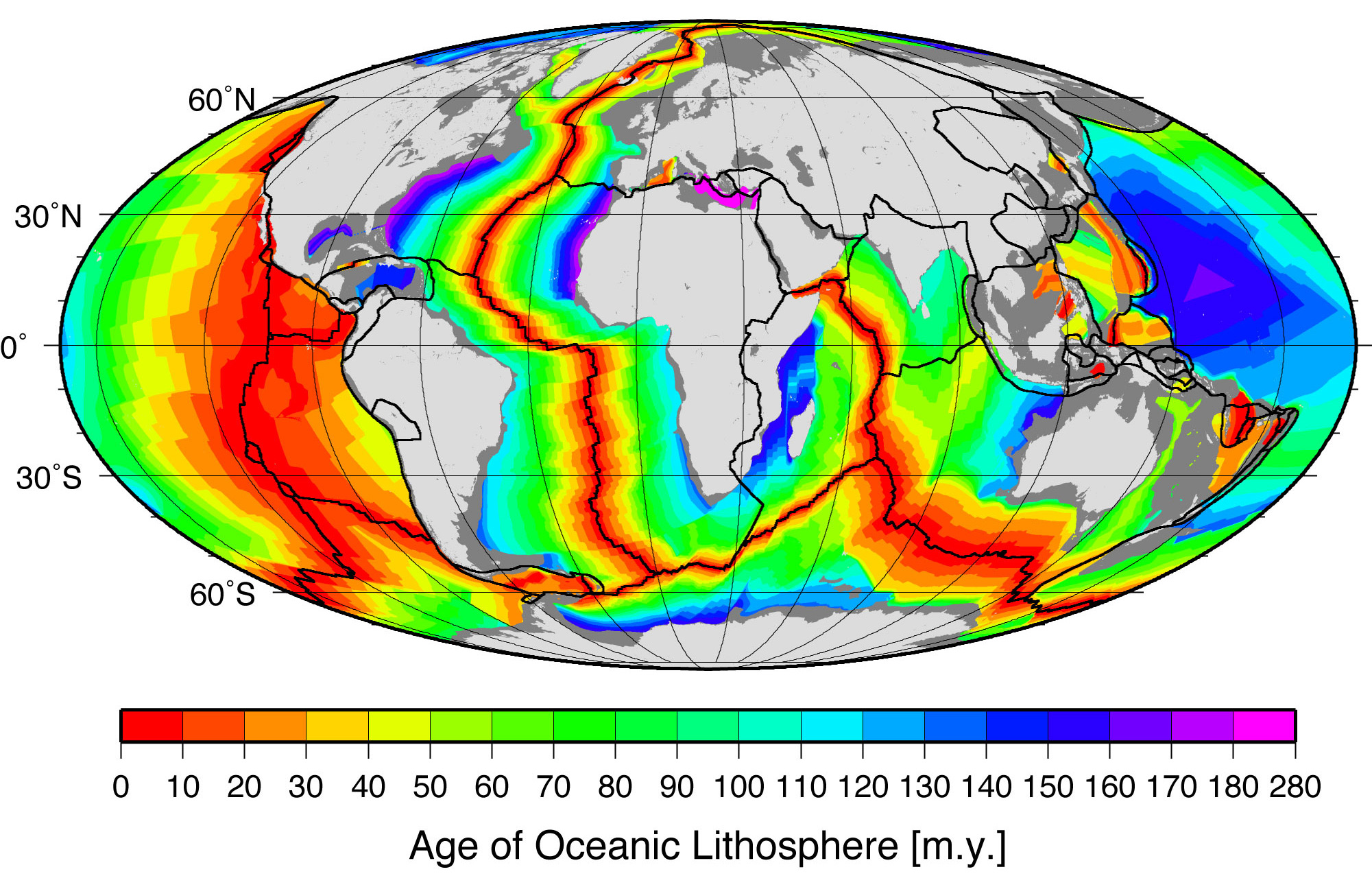
The ridge feature is created by the accumulation of hot lithosphere material, which is lighter than the dense underlying asthenosphere. This chunk of isostatically buoyant lithosphere sits partially submerged and partially exposed on the asthenosphere, like an ice cube floating in a glass of water.
As the ridge continues to spread, the lithosphere material is pulled away from the area of volcanism and becomes colder and denser. As it continues to spread and cool, the lithosphere settles into wide swathes of relatively featureless topography called abyssal plains with lower topography.
This model of ridge formation suggests the sections of lithosphere furthest away from the mid-ocean ridges will be the oldest. Scientists have tested this idea by comparing the age of rocks located in various locations on the ocean floor. Rocks found near ridges are younger than those found far away from any ridges. Sediment accumulation patterns also confirm the idea of sea-floor spreading. Sediment layers tend to be thinner near mid-ocean ridges, indicating it has had less time to build up.
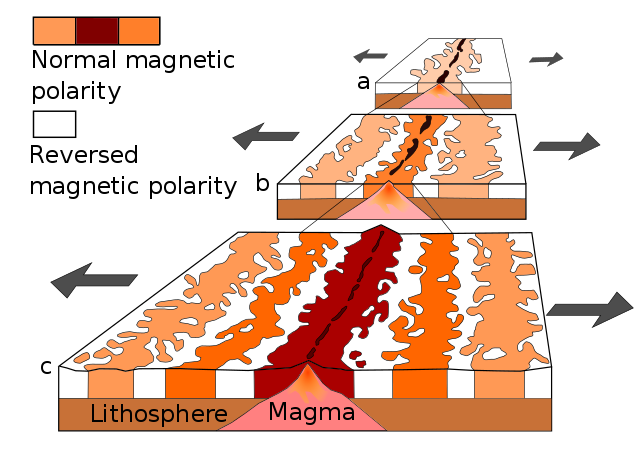
As mentioned in the section on paleomagnetism and the development of plate tectonic theory, scientists noticed mid-ocean ridges contained unique magnetic anomalies that show up as symmetrical striping on both sides of the ridge. The Vine-Matthews-Morley hypothesis proposes these alternating reversals are created by the earth’s magnetic field being imprinted into magma after it emerges from the ridge. Very hot magma has no magnetic field. As the oceanic plates get pulled apart, the magma cools below the Curie point, the temperature below which a magnetic field gets locked into magnetic minerals. The alternating magnetic reversals in the rocks reflects the periodic swapping of earth’s magnetic north and south poles. This paleomagnetic pattern provides a great historical record of ocean-floor movement, and is used to reconstruct past tectonic activity and determine rates of ridge spreading.

Video 2.2: Pangea breakup and formation of the northern Atlantic Ocean.
If you are using an offline version of this text, access this YouTube video via the QR code.
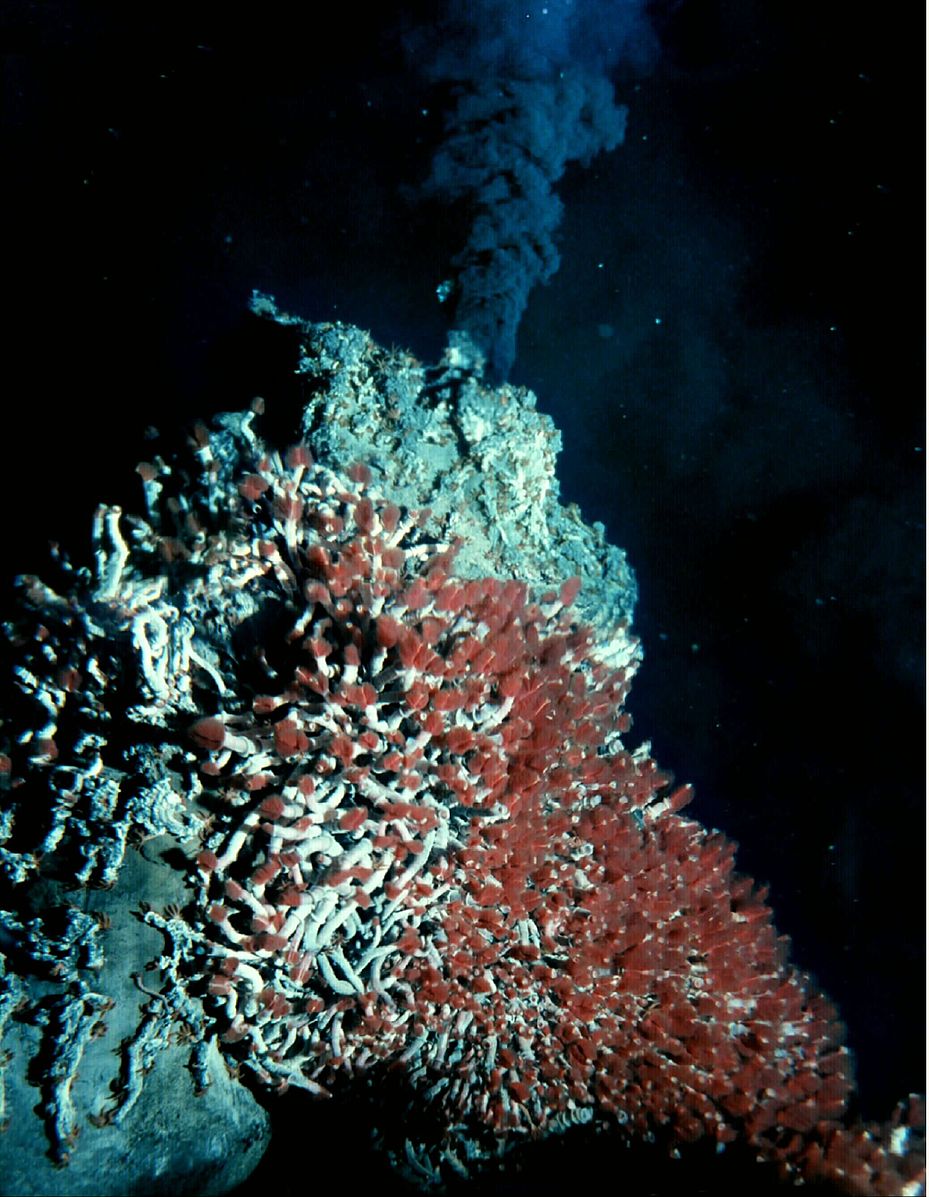
Thanks to their distinctive geology, mid-ocean ridges are home to some of the most unique ecosystems ever discovered. The ridges are often studded with hydrothermal vents, deep fissures that allow seawater to circulate through the upper portions of the oceanic plate and interact with hot rock. The super-heated seawater rises back up to the surface of the plate, carrying dissolved gasses and minerals, and small particulates. The resulting emitted hydrothermal water looks like black underwater smoke.
Scientists had known about these geothermal areas on the ocean floor for some time. However, it was not until 1977, when scientists piloting a deep submergence vehicle, the Alvin, discovered a thriving community of organisms clustered around these hydrothermal vents. These unique organisms, which include 10-foot-long tube worms taller than people, live in the complete darkness of the ocean floor deprived of oxygen and sunlight. They use geothermal energy provided by the vents and a process called bacterial chemosynthesis to feed on sulfur compounds. Before this discovery, scientists believed life on earth could not exist without photosynthesis, a process that requires sunlight. Some scientists suggest this type of environment could have been the origin of life on Earth, and perhaps even extraterrestrial life elsewhere in the galaxy, such as on Jupiter’s moon Europa.

Take this quiz to check your comprehension of this section.
If you are using an offline version of this text, access the quiz for section 2.4 via the QR code.
2.5 Transform Boundaries
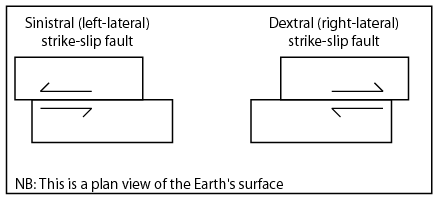
A transform boundary, sometimes called a strike-slip or conservative boundary, is where the lithospheric plates slide past each other in the horizontal plane. This movement is described based on the perspective of an observer standing on one of the plates, looking across the boundary at the opposing plate. Dextral, also known as right-lateral, movement describes the opposing plate moving to the right. Sinistral, also known as left lateral, movement describe the opposing plate moving to the left.
Most transform boundaries are found on the ocean floor, around mid-ocean ridges. These boundaries form aseismic fracture zones, filled with earthquake-free transform faults, to accommodate different rates of spreading occurring at the ridge.
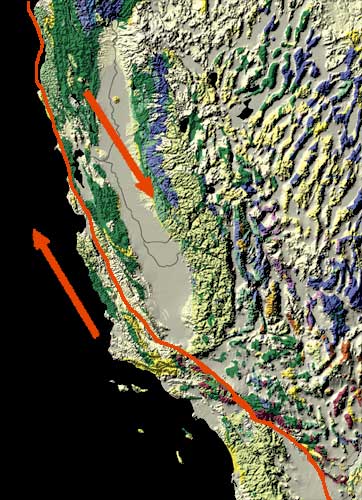
Some transform boundaries produce significant seismic activity, primarily as earthquakes, with very little mountain-building or volcanism. This type of transform boundary may contain a single fault or series of faults, which develop in places where plate tectonic stresses are transferred to the surface. As with other types of active boundaries, if the plates are unable to shear past each other the tectonic forces will continue to build up. If the built up energy between the plates is suddenly released, the result is an earthquake.
In the eyes of humanity, the most significant transform faults occur within continental plates, and have a shearing motion that frequently produces moderate-to-large magnitude earthquakes. Notable examples include the San Andreas Fault in California, Northern and Eastern Anatolian Faults in Turkey, Altyn Tagh Fault in central Asia, and Alpine Fault in New Zealand.
2.5.1 Transpression and Transtension
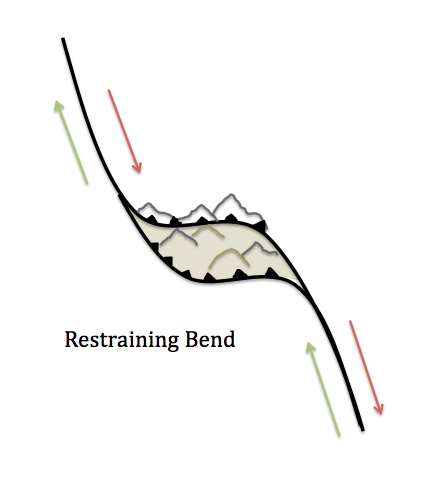
Bends along transform faults may create compressional or extensional forces that cause secondary faulting zones. Transpression occurs where there is a component of compression in addition to the shearing motion. These forces build up around the area of the bend, where the opposing plates are restricted from sliding past each other. As the forces continue to build up, they create mountains in the restraining bend around the fault. The Big Bend area, located in the southern part of the San Andreas Fault includes a large area of transpression where many mountains have been built, moved, and even rotated.
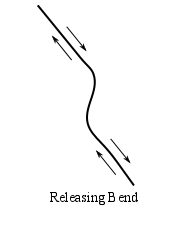
Transtension zones require a fault that includes a releasing bend, where the plates are being pulled apart by extensional forces. Depressions and sometimes volcanism develop in the releasing bend, along the fault. The Dead Sea found between Israel and Jordan, and the Salton Sea of California are examples of basins formed by transtensional forces.
2.5.2 Piercing Points
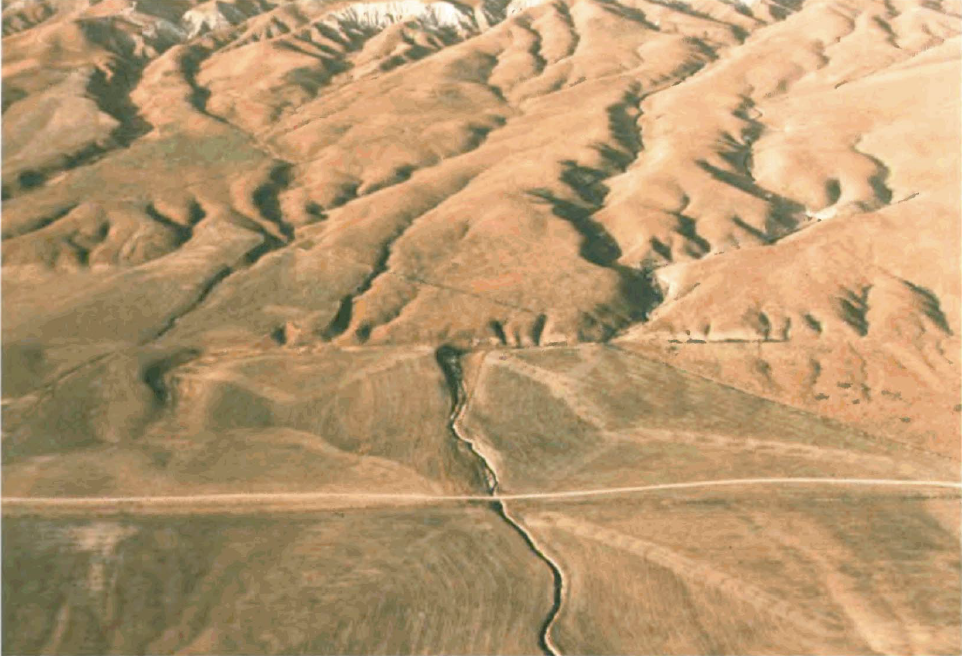
When a geological feature is cut by a fault, it is called a piercing point. Piercing points are very useful for recreating past fault movement, especially along transform boundaries. Transform faults are unique because their horizontal motion keeps a geological feature relatively intact, preserving the record of what happened. Other types of faults—normal and reverse —tend to be more destructive, obscuring or destroying these features. The best type of piercing point includes unique patterns that are used to match the parts of a geological feature separated by fault movement. Detailed studies of piercing points show the San Andreas Fault has experienced over 225 km of movement in the last 20 million years, and this movement occurred at three different fault traces.

Video 2.3: Video of the origin of the San Andreas fault. As the mid-ocean ridge subducts, the relative motion between the remaining plates become transform, forming the fault system. Note that because the motion of the plates is not exactly parallel to the fault, it causes divergent motion in the interior of North America.
If you are using an offline version of this text, access this YouTube video via the QR code.

Take this quiz to check your comprehension of this section.
If you are using an offline version of this text, access the quiz for section 2.5 via the QR code.
2.6 The Wilson Cycle
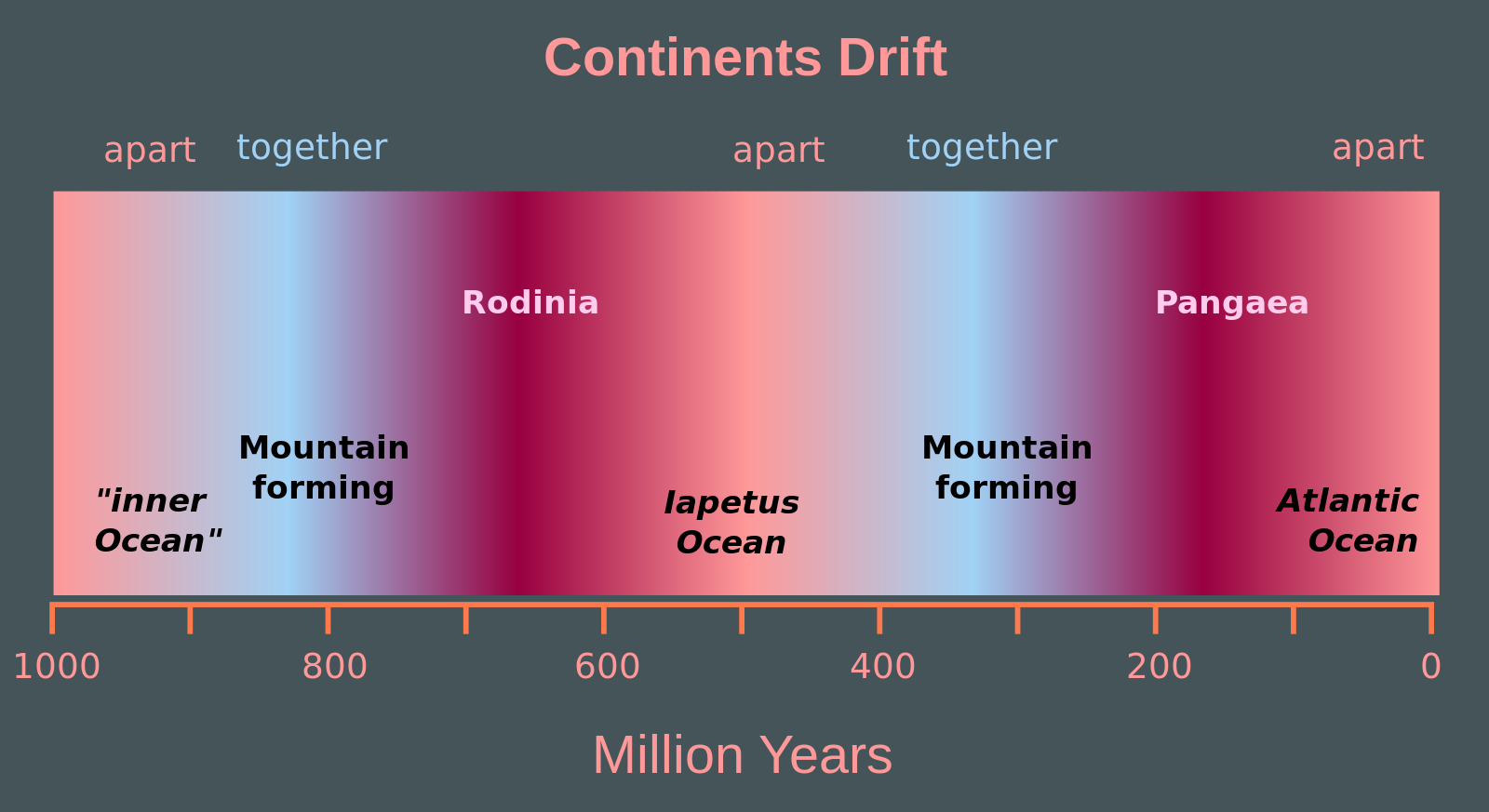
The Wilson Cycle is named for J. Tuzo Wilson who first described it in 1966, and it outlines the ongoing origin and breakup of supercontinents, such as Pangea and Rodinia. Scientists have determined this cycle has been operating for at least three billion years and possibly earlier.
There are a number of hypotheses about how the Wilson Cycle works. One mechanism proposes that rifting happens because continental plates reflect the heat much better than oceanic plates. When continents congregate together, they reflect more of the Earth’s heat back into the mantle, generating more vigorous convection currents that then start the continental rifting process. Some geologists believe mantle plumes are remnants of these periods of increased mantle temperature and convection upwelling, and study them for clues about the origin of continental rifting.
The mechanism behind how supercontinents are created is still largely a mystery. There are three schools of thought about what continues to drive the continents further apart and eventually bring them together. The ridge-push hypothesis suggests after the initial rifting event, plates continue to be pushed apart by mid-ocean spreading centers and their underlying convection currents. Slab-pull proposes the plates are pulled apart by descending slabs in the subduction zones of the oceanic–continental margins. A third idea, gravitational sliding, attributes the movement to gravitational forces pulling the lithospheric plates down from the elevated mid-ocean ridges and across the underlying asthenosphere. Current evidence seems to support slab pull more than ridge push or gravitational sliding.
2.7 Hotspots
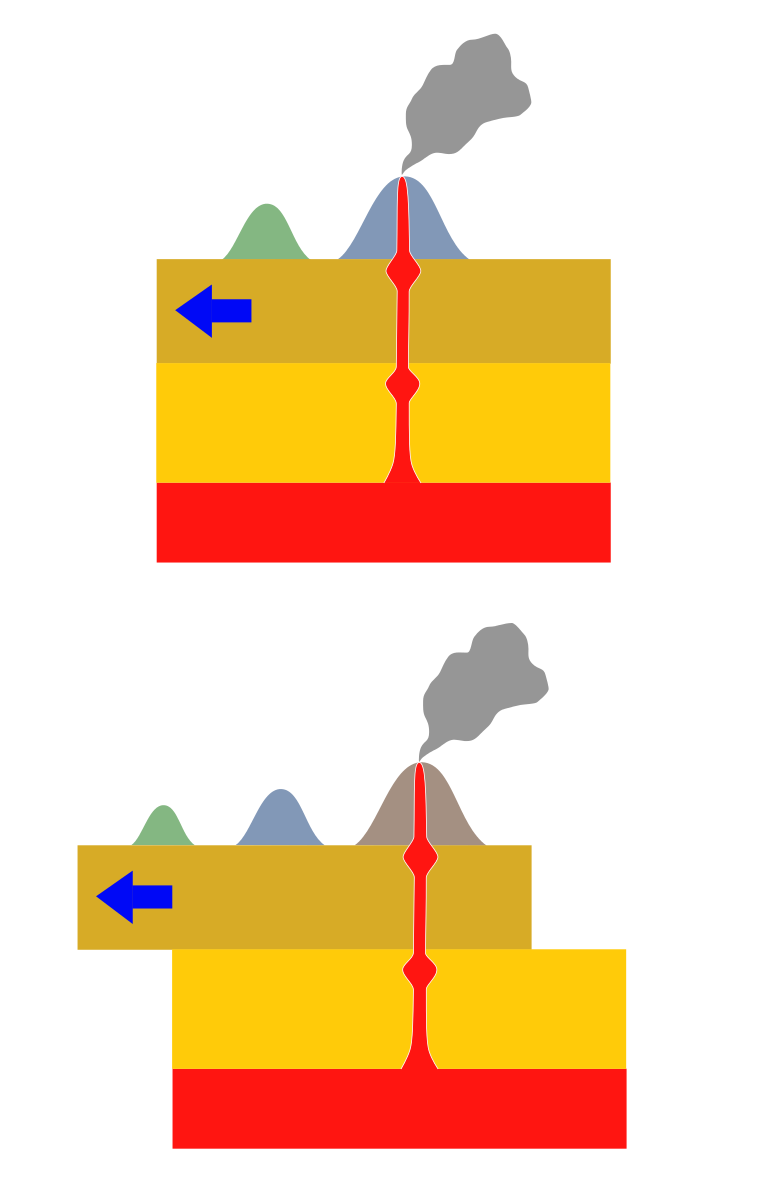
The Wilson Cycle provides a broad overview of tectonic plate movement. To analyze plate movement more precisely, scientists study hotspots. First postulated by J. Tuzo Wilson in 1963, a hotspot is an area in the lithospheric plate where molten magma breaks through and creates a volcanic center, islands in the ocean and mountains on land. As the plate moves across the hotspot, the volcano center becomes extinct because it is no longer over an active magma source. Instead, the magma emerges through another area in the plate to create a new active volcano. Over time, the combination of moving plate and stationary hotspot creates a chain of islands or mountains. The classic definition of hotspots states they do not move, although recent evidence suggests that there may be exceptions.
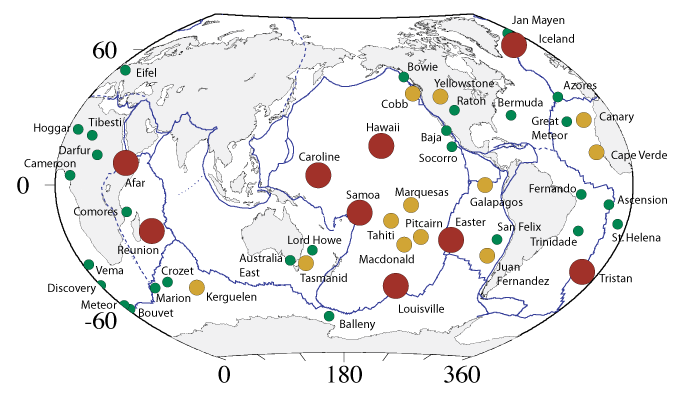
Hotspots are the only types of volcanism not associated with subduction or rifting zones at plate boundaries; they seem totally disconnected from any plate tectonics processes, such as earthquakes. However, there are relationships between hotspots and plate tectonics. There are several hotspots, current and former, that are believed to have begun at the time of rifting. Also, scientists use the age of volcanic eruptions and shape of the chain to quantify the rate and direction of plate movement relative to the hotspot.
Scientists are divided over how magma is generated in hotspots. Some suggest that hotspots originate from super-heated material from as deep as the core that reaches the Earth’s crust as a mantle plume. Others argue the molten material that feeds hotspots is sourced from the mantle. Of course, it is difficult to collect data from these deep-Earth features due to the extremely high pressure and temperature.
How hotspots are initiated is another highly debated subject. The prevailing mechanism has hotspots starting in divergent boundaries during supercontinent rifting. Scientists have identified a number of current and past hotspots believed to have begun this way. Subducting slabs have also been named as causing mantle plumes and hot-spot volcanism. Some geologists have suggested another geological process not involving plate tectonics may be involved, such as a large space objects crashing into Earth. Regardless of how they are formed, dozens are on the Earth. Some well-known examples include the Tahiti Islands, Afar Triangle, Easter Island, Iceland, Galapagos Islands, and Samoan Islands. The United States is home to two of the largest and best-studied hotspots: Hawaii and Yellowstone.
2.7.1 Hawaiian Hotspot
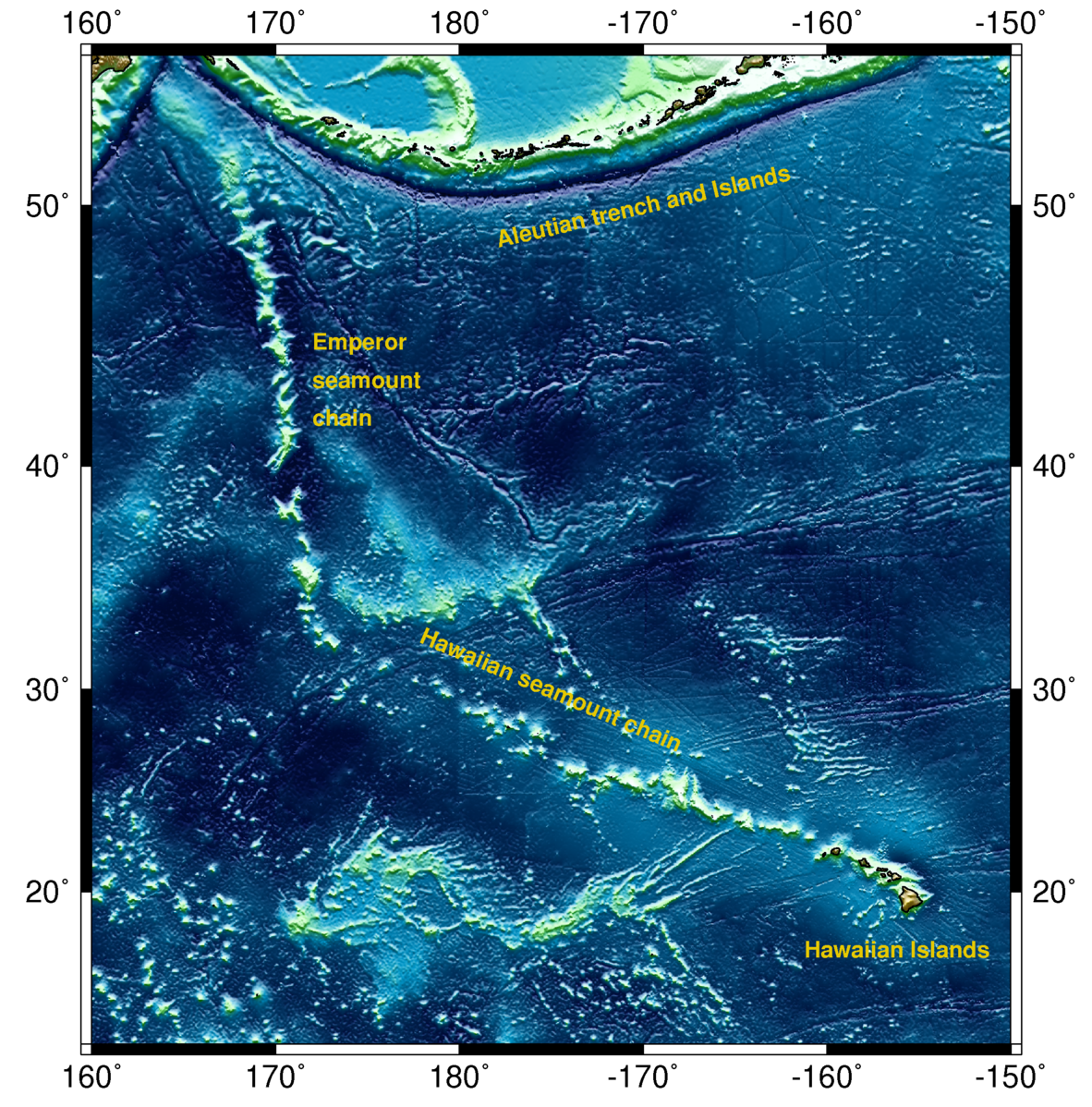
The active volcanoes in Hawaii represent one of the most active hotspot sites on earth. Scientific evidence indicates the Hawaiian hotspot is at least 80 million years old. Geologists believe it is actually much older; however any rocks with proof of this have been subducted under the ocean floor. The big island of Hawaii sits atop a large mantle plume that marks the active hotspot. The Kilauea volcano is the main vent for this hotspot and has been actively erupting since 1983.
This enormous volcanic island chain, much of which is underwater, stretches across the Pacific for almost 6,000 km. The seamount chain’s most striking feature is a sharp 60-degree bend located at the midpoint, which marks a significant change in plate movement direction that occurred 50 million years ago. The change in direction has been more often linked to a plate reconfiguration, but also to other things like plume migration.
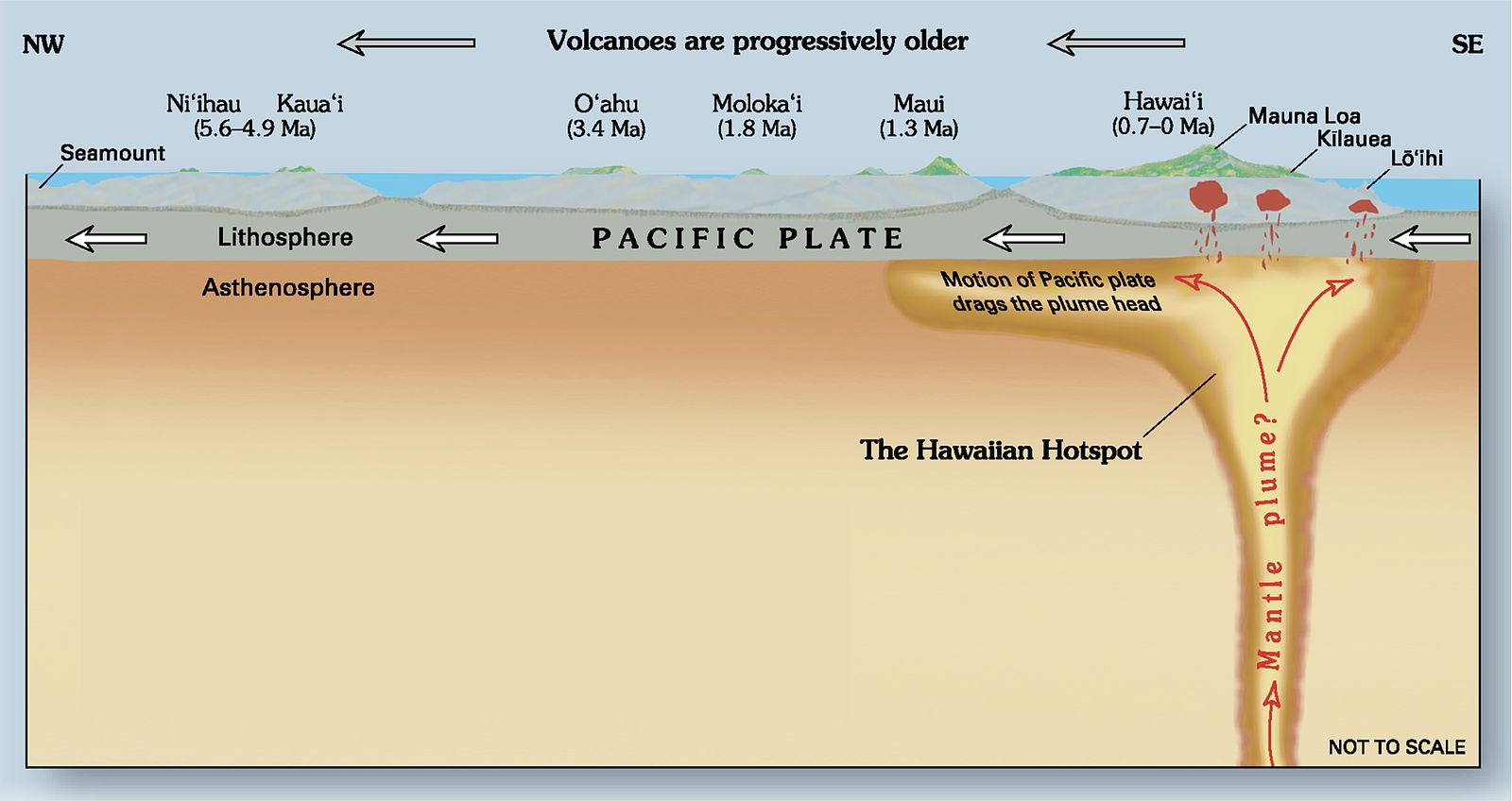
In an attempt to map the Hawaiian mantle plume as far down as the lower mantle, scientists have used tomography, a type of three-dimensional seismic imaging. This information—along with other evidence gathered from rock ages, vegetation types, and island size—indicate the oldest islands in the chain are located the furthest away from the active hotspot.
2.7.2 Yellowstone Hotspot
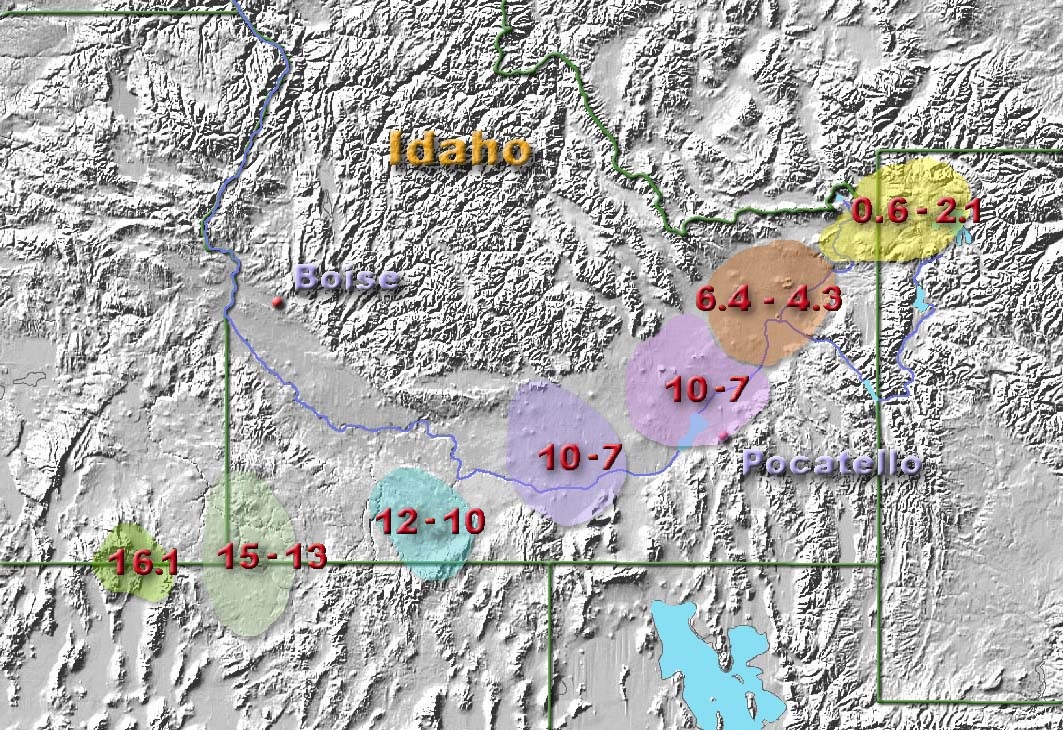
Like the Hawaiian version, the Yellowstone hotspot is formed by magma rising through the lithosphere. What makes it different is this hotspot is located under a thick, continental plate. Hawaii sits on a thin oceanic plate, which is easily breached by magma coming to the surface. At Yellowstone, the thick continental plate presents a much more difficult barrier for magma to penetrate. When it does emerge, the eruptions are generally much more violent. Thankfully they are also less frequent.
Over 15 million years of eruptions by this hotspot have carved a curved path across the western United States. It has been suggested the Yellowstone hotspot is connected to the much older Columbia River flood basalts and even to 70 million-year-old volcanism found in the Yukon region of Canada.
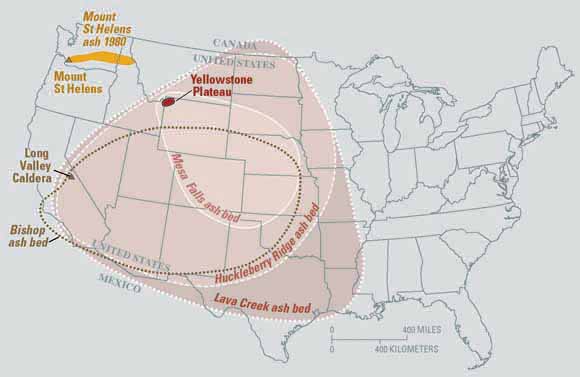
The most recent major eruption of this hotspot created the Yellowstone Caldera and Lava Creek tuff formation approximately 631,000 years ago. The eruption threw 1,000 cubic kilometers of ash and magma into the atmosphere, some of which was found as far away as Mississippi. Should the hotspot erupt again, scientists predict it will be another massive event. This would be a calamity reaching far beyond the western United States. These super volcanic eruptions fill the earth’s atmosphere with so much gas and ash, they block sunlight from reaching the earth. Not only would this drastically alter climates and environments around the globe, it could affect worldwide food production.

Take this quiz to check your comprehension of this section.
If you are using an offline version of this text, access the quiz for sections 2.6 and 2.7 via the QR code.
Summary

Video 2.4: Plate tectonics.
If you are using an offline version of this text, access this YouTube video via the QR code.
Plate tectonics is a unifying theory; it explains nearly all of the major geologic processes on Earth. Since its early inception in the 1950s and 1960s, geologists have been guided by this revolutionary perception of the world. The theory of plate tectonics states the surface layer of the Earth is broken into a network of solid, relatively brittle plates. Underneath the plates is a much hotter and more ductile layer that contains zones of convective upwelling generated by the interior heat of Earth. These convection currents move the surface plates around—bringing them together, pulling them apart, and shearing them side-by-side. Earthquakes and volcanoes form at the boundaries where the plates interact, with the exception of volcanic hotspots, which are not caused by plate movement.

Take this quiz to check your comprehension of this chapter.
If you are using an offline version of this text, access the quiz for chapter 2 via the QR code.
URLs Linked Within This Chapter
Audio pronunciation: https://www.merriam-webster.com/dictionary/Mohorovicic%20discontinuity
Animation 1: Basin and Range Structures. How do they form? [Video: 0:52] https://youtu.be/TvvWqAdNV84
Animation 2: Basin & Range: Extension, Erosion, Sedimentation. [Video: 0:31] https://www.youtube.com/watch?v=7DxcAMmNeZk
Text References
- Aitta, A., 2006, Iron melting curve with a tricritical point: J. Stat. Mech., v. 2006, no. 12, p. P12015.
- Alfe, D., Gillan, M.J., and Price, G.D., 2002, Composition and temperature of the Earth’s core constrained by combining ab initio calculations and seismic data: Earth Planet. Sci. Lett., v. 195, no. 1, p. 91–98.
- Atwater, T., 1970, Implications of Plate Tectonics for the Cenozoic Tectonic Evolution of Western North America: Geol. Soc. Am. Bull., v. 81, no. 12, p. 3513–3536., doi: 10.1130/0016-7606(1970)81[3513:IOPTFT]2.0.CO;2.
- Bacon, F., and Montagu, B., 1848, The Works of Francis Bacon, Lord Chancellor of England: With a Life of the Author: The Works of Francis Bacon, Lord Chancellor of England: With a Life of the Author, Parry & McMillan, The Works of Francis Bacon, Lord Chancellor of England: With a Life of the Author.
- Benioff, H., 1949, Seismic evidence for the fault origin of oceanic deeps: Geological Society of America Bulletin, v. 60, no. 12, p. 1837–1856., doi: 10.1130/0016-7606(1949)60[1837:SEFTFO]2.0.CO;2.
- Birch, F., 1952, Elasticity and constitution of the Earth’s interior: J. Geophys. Res., v. 57, no. 2, p. 227–286., doi: 10.1029/JZ057i002p00227.
- Birch, F., 1964, Density and composition of mantle and core: J. Geophys. Res., v. 69, no. 20, p. 4377–4388.
- Bott, M.H.P., 1993, Modelling the plate-driving mechanism: Journal of the Geological Society, v. 150, no. 5, p. 941–951., doi: 10.1144/gsjgs.150.5.0941.
- Coats, R.R., 1962, Magma type and crustal structure in the Aleutian Arc, in The Crust of the Pacific Basin: American Geophysical Union, p. 92–109., doi: 10.1029/GM006p0092.
- Conrad, C.P., and Lithgow-Bertelloni, C., 2002, How mantle slabs drive plate tectonics: Science (New York, N.Y.), v. 298, no. 5591, p. 207–209., doi: 10.1126/science.1074161.
- Corliss, J.B., Dymond, J.G., Gordon, L.I., Edmond, J.M., von Heezen, R.P., Ballard, R.D., Green, K., Williams, D.L., Bainbridge, A., Crane, K., and van Andel, T.H., 1979, Submarine thermal springs on the Galapagos Rift: Science, v. 203, p. 107321083.
- Davis, E.E., and Lister, C.R.B., 1974, Fundamentals of ridge crest topography: Earth Planet. Sci. Lett., v. 21, no. 4, p. 405–413.
- Dawson, J.B., Pinkerton, H., Norton, G.E., and Pyle, D.M., 1990, Physicochemical properties of alkali carbonatite lavas: Data from the 1988 eruption of Oldoinyo Lengai, Tanzania: Geology, v. 18, no. 3, p. 260–263.
- Drake, E.T., 1976, Alfred Wegener’s reconstruction of Pangea: Geology, v. 4, no. 1, p. 41–44., DOI: 10.1130/0091-7613(1976)4<41:AWROP>2.0.CO;2
- Engdahl, E.R., Flynn, E.A., and Masse, R.P., 1974, Differential PkiKP travel times and the radius of the core: Geophysical J Royal Astro Soc, v. 40, p. 457–463.
- Ewing, M., Ewing, J.I., and Talwani, M., 1964, Sediment distribution in the oceans: The Mid-Atlantic Ridge: Geol. Soc. Am. Bull., v. 75, no. 1, p. 17–36., doi: 10.1130/0016-7606(1964)75[17:SDITOT]2.0.CO;2.
- Ewing, M., Houtz, R., and Ewing, J., 1969, South Pacific sediment distribution: J. Geophys. Res., v. 74, no. 10, p. 2477–2493., doi: 10.1029/JB074i010p02477.
- Fernandez, L.M., and Careaga, J., 1968, The thickness of the crust in central United States and La Paz, Bolivia, from the spectrum of longitudinal seismic waves: Bull. Seismol. Soc. Am., v. 58, no. 2, p. 711–741.
- Fluegel, von H.W., 1980, Wegener-Ampferer-Schwinner. Ein Beitrag zur Geschichte der Geologie in Österreich: Mitt. Oesterr. Geol. Ges., v. 73, p. 237–254.
- Forsyth, D.W., 1975, The Early Structural Evolution and Anisotropy of the Oceanic Upper Mantle: Geophys. J. Int., v. 43, no. 1, p. 103–162., doi: 10.1111/j.1365-246X.1975.tb00630.x.
- Frankel, H., 1982, The Development, Reception, and Acceptance of the Vine-Matthews-Morley Hypothesis: Hist. Stud. Phys. Biol. Sci., v. 13, no. 1, p. 1–39.
- Fukao, Y., and Obayashi, M., 2013, Subducted slabs stagnant above, penetrating through, and trapped below the 660 km discontinuity: J. Geophys. Res. [Solid Earth], v. 118, no. 11, p. 2013JB010466.
- Hagstrum, J.T., 2005, Antipodal hotspots and bipolar catastrophes: Were oceanic large-body impacts the cause? Earth Planet. Sci. Lett., v. 236, no. 1–2, p. 13–27.
- Hanks, T.C., and Anderson, D.L., 1969, The early thermal history of the earth: Phys. Earth Planet. Inter., v. 2, no. 1, p. 19–29.
- Heezen, B.C., and Tharp, M., 1965, Tectonic Fabric of the Atlantic and Indian Oceans and Continental Drift: Philosophical Transactions of the Royal Society of London A: Mathematical, Physical and Engineering Sciences, v. 258, no. 1088, p. 90–106., doi: 10.1098/rsta.1965.0024.
- Heller, P.L., Bowdler, S.S., Chambers, H.P., Coogan, J.C., Hagen, E.S., Shuster, M.W., Winslow, N.S., and Lawton, T.F., 1986, Time of initial thrusting in the Sevier orogenic belt, Idaho-Wyoming and Utah: Geology, v. 14, no. 5, p. 388–391.
- Herak, D., and Herak, M., 2007, Andrija Mohorovičić (1857-1936)—On the occasion of the 150th anniversary of his birth: Seismol. Res. Lett., v. 78, no. 6, p. 671–674.
- Hess, H.H., 1962, History of ocean basins: Petrologic studies, v. 4, p. 599–620.
- Hutson, P., Middleton, J., and Miller, D., 2003, Collision Zones: Online, http://www.geosci.usyd.edu.au/users/prey/ACSGT/EReports/eR.2003/GroupD/Report1/web%20pages/contents.html, accessed June 2017.
- Isacks, B., Oliver, J., and Sykes, L.R., 1968, Seismology and the new global tectonics: J. Geophys. Res., v. 73, no. 18, p. 5855–5899.
- Ito, E., and Takahashi, E., 1989, Postspinel transformations in the system Mg2SiO4-Fe2SiO4 and some geophysical implications: J. Geophys. Res. [Solid Earth], v. 94, no. B8, p. 10637–10646.
- Jacoby, W.R., 1981, Modern concepts of Earth dynamics anticipated by Alfred Wegener in 1912: Geology, v. 9, no. 1, p. 25–27., doi: <a href=”https://doi.org/10.1130/0091-7613(1981)92.0.CO;2″>10.1130/0091-7613(1981)9<25:MCOEDA>2.0.CO;2.
- Jakosky, B.M., Grebowsky, J.M., Luhmann, J.G., Connerney, J., Eparvier, F., Ergun, R., Halekas, J., Larson, D., Mahaffy, P., McFadden, J., Mitchell, D.F., Schneider, N., Zurek, R., Bougher, S., and others, 2015, MAVEN observations of the response of Mars to an interplanetary coronal mass ejection: Science, v. 350, no. 6261, p. aad0210.
- James, D.E., Fouch, M.J., Carlson, R.W., and Roth, J.B., 2011, Slab fragmentation, edge flow and the origin of the Yellowstone hotspot track: Earth Planet. Sci. Lett., v. 311, no. 1–2, p. 124–135.
- Ji, Y., and Nataf, H.-C., 1998, Detection of mantle plumes in the lower mantle by diffraction tomography: Hawaii: Earth Planet. Sci. Lett., v. 159, no. 3–4, p. 99–115.
- Johnston, S.T., Jane Wynne, P., Francis, D., Hart, C.J.R., Enkin, R.J., and Engebretson, D.C., 1996, Yellowstone in Yukon: The Late Cretaceous Carmacks Group: Geology, v. 24, no. 11, p. 997–1000.
- Kearey, P., Klepeis, K.A., and Vine, F.J., 2009, Global Tectonics: Oxford ; Chichester, West Sussex ; Hoboken, NJ, Wiley-Blackwell, 496 p.
- Le Pichon, X., 1968, Sea-floor spreading and continental drift: J. Geophys. Res., v. 73, no. 12, p. 3661–3697.
- Lehmann, I., 1936, P’, Publ: Bur. Centr. Seism. Internat. Serie A, v. 14, p. 87–115.
- Mantovani, R., 1889, Les fractures de l’écorce terrestre et la théorie de Laplace: Bull. Soc. Sc. et Arts Réunion, p. 41–53.
- Mason, R.G., 1958, A magnetic survey off the west coast of the United-States between latitudes 32-degrees-N and 36-degrees-N longitudes 121-degrees-W and 128-degrees-W: Geophysical Journal of the Royal Astronomical Society, v. 1, no. 4, p. 320.
- Mason, R.G., and Raff, A.D., 1961, Magnetic Survey Off the West Coast of North America, 32° N. Latitude to 42° N. Latitude: Geological Society of America Bulletin, v. 72, no. 8, p. 1259–1265., doi: 10.1130/0016-7606(1961)72[1259:MSOTWC]2.0.CO;2.
- McCollom, T.M., 1999, Methanogenesis as a potential source of chemical energy for primary biomass production by autotrophic organisms in hydrothermal systems on Europa: J. Geophys. Res., v. 104, no. E12, p. 30729–30742., doi: 10.1029/1999JE001126.
- McKenzie, D.P., and Parker, R.L., 1967, The North Pacific: an Example of Tectonics on a Sphere: Nature, v. 216, p. 1276–1280., doi: 10.1038/2161276a0.
- Miller, A.R., Densmore, C.D., Degens, E.T., Hathaway, J.C., Manheim, F.T., McFarlin, P.F., Pocklington, R., and Jokela, A., 1966, Hot brines and recent iron deposits in deeps of the Red Sea: Geochimica et Cosmochimica Acta, v. 30, no. 3, p. 341–359., doi: 10.1016/0016-7037(66)90007-X.
- Morgan, W.J., 1968, Rises, trenches, great faults, and crustal blocks: J. Geophys. Res., v. 73, no. 6, p. 1959–1982., doi: 10.1029/JB073i006p01959.
- Mueller, S., and Phillips, R.J., 1991, On the initiation of subduction: J. Geophys. Res. [Solid Earth], v. 96, no. B1, p. 651–665.
- Oldham, R.D., 1906, The constitution of the interior of the Earth, as revealed by earthquakes: Q. J. Geol. Soc. London, v. 62, no. 1–4, p. 456–475.
- Pasyanos, M.E., 2010, Lithospheric thickness modeled from long-period surface wave dispersion: Tectonophysics, v. 481, no. 1–4, p. 38–50.
- Powell, R.E., and Weldon, R.J., 1992, Evolution of the San Andreas fault: Annu. Rev. Earth Planet. Sci., v. 20, p. 431.
- Raff, A.D., and Mason, R.G., 1961, Magnetic Survey Off the West Coast of North America, 40 N. Latitude to 52 N. Latitude: Geological Society of America Bulletin, v. 72, no. 8, p. 1267–1270., doi: 10.1130/0016-7606(1961)72[1267:MSOTWC]2.0.CO;2.
- Runcorn, S.K., 1965, Palaeomagnetic comparisons between Europe and North America: Philosophical Transactions of the Royal Society of London A: Mathematical, Physical and Engineering Sciences, v. 258, no. 1088, p. 1–11.
- Saito, T., Ewing, M., and Burckle, L.H., 1966, Tertiary sediment from the mid-atlantic ridge: Science, v. 151, no. 3714, p. 1075–1079., doi: 10.1126/science.151.3714.1075.
- Satake, K., and Atwater, B.F., 2007, Long-term perspectives on giant earthquakes and tsunamis at subduction zones*: Annu. Rev. Earth Planet. Sci., v. 35, p. 349–374.
- Scheidegger, A.E., 1953, Examination of the physics of theories of orogenesis: Geol. Soc. Am. Bull., v. 64, no. 2, p. 127–150., doi: 10.1130/0016-7606(1953)64[127:EOTPOT]2.0.CO;2.
- Simpson, G.G., 1943, Mammals and the nature of continents: Am. J. Sci., v. 241, no. 1, p. 1–31.
- Starr, A.M., 2015, Ambient resonance of rock arches: Salt Lake City, Utah, University of Utah, 134 p.
- Stern, R.J., 1998, A subduction primer for instructors of introductory geology courses and authors of introductory-geology textbooks: J. Geosci. Educ., v. 46, p. 221.
- Stern, R.J., 2004, Subduction initiation: spontaneous and induced: Earth Planet. Sci. Lett., v. 226, no. 3–4, p. 275–292.
- Stich, D., Mancilla, F. de L., Pondrelli, S., and Morales, J., 2007, Source analysis of the February 12th 2007, Mw 6.0 Horseshoe earthquake: Implications for the 1755 Lisbon earthquake: Geophys. Res. Lett., v. 34, no. 12, p. L12308.
- Tatsumi, Y., 2005, The subduction factory: how it operates in the evolving Earth: GSA Today, v. 15, no. 7, p. 4.
- Todo, Y., Kitazato, H., Hashimoto, J., and Gooday, A.J., 2005, Simple foraminifera flourish at the ocean’s deepest point: Science, v. 307, no. 5710, p. 689., doi: 10.1126/science.1105407.
- Tolstoy, I., and Ewing, M., 1949, North Atlantic hydrography and the Mid-Atlantic Ridge: Geol. Soc. Am. Bull., v. 60, no. 10, p. 1527–1540., doi: 10.1130/0016-7606(1949)60[1527:NAHATM]2.0.CO;2.
- Vine, F.J., and Matthews, D.H., 1963, Magnetic anomalies over oceanic ridges: Nature, v. 199, no. 4897, p. 947–949.
- Wächtershäuser, G., 1990, Evolution of the first metabolic cycles: Proc. Natl. Acad. Sci. U. S. A., v. 87, no. 1, p. 200–204.
- Wadati, K., 1935, On the activity of deep-focus earthquakes in the Japan Islands and neighbourhoods: Geophys. Mag., v. 8, no. 3–4, p. 305–325.
- Waszek, L., Irving, J., and Deuss, A., 2011, Reconciling the hemispherical structure of Earth’s inner core with its super-rotation: Nat. Geosci., v. 4, no. 4, p. 264–267., doi: 10.1038/ngeo1083.
- Wegener, A., 1912, Die Entstehung der Kontinente: Geol. Rundsch., v. 3, no. 4, p. 276–292., doi: 10.1007/BF02202896.
- Wegener, A., 1920, Die entstehung der kontinente und ozeane: Рипол Классик.
- Wells, H.G., Huxley, J., and Wells, G.P., 1931, The Science of Life: Philosophy, v. 6, no. 24, p. 506–507.
- White, I.C., and Moreira, C., 1908, Commissão de estudos das minas de Carvão de Pedra do Brazil.
- de Wijs, G.A., Kresse, G., Vočadlo, L., Dobson, D., Alfè, D., Gillan, M.J., and Price, G.D., 1998, The viscosity of liquid iron at the physical conditions of the Earth’s core: Nature, v. 392, no. 6678, p. 805–807., doi: 10.1038/33905.
- Wilson, J.T., 1966, Did the Atlantic close and then re-open? Nature.
- Wilson, M., 1993, Plate-moving mechanisms: constraints and controversies: Journal of the Geological Society, v. 150, no. 5, p. 923–926., doi: 10.1144/gsjgs.150.5.0923.
- Wyllie, P.J., 1970, Ultramafic rocks and the upper mantle, in Morgan, B.A., editor, Fiftieth anniversary symposia: Mineralogy and petrology of the Upper Mantle; Sulfides; Mineralogy and geochemistry of non-marine evaporites: Washington, DC, Mineralogical Society of America, p. 3–32.
- Zhou, Z., 2004, The origin and early evolution of birds: discoveries, disputes, and perspectives from fossil evidence: Naturwissenschaften, v. 91, no. 10, p. 455–471.
Figure References
Figure 2.1: Detailed map of all known plates, their boundaries, and movements. Eric Gaba. 2006-10, updated 2015-09. CC BY-SA 2.5. https://commons.wikimedia.org/wiki/File:Tectonic_plates_boundaries_detailed-en.svg
Figure 2.2: Wegener later in his life, ca. 1924-1930. Author unknown. ca. 1924 and 1930. Public domain. https://commons.wikimedia.org/wiki/File:Alfred_Wegener_ca.1924-30.jpg
Figure 2.3: Snider-Pellegrini’s map showing the continental fit and separation, 1858. Antonio Snider-Pellegrini. 1858. Public domain. https://commons.wikimedia.org/wiki/File:Antonio_Snider-Pellegrini_Opening_of_the_Atlantic.jpg
Figure 2.4: Map of world elevations. Tahaisik. 2013. CC BY-SA 3.0. https://commons.wikimedia.org/wiki/File:Tahacik.jpg
Figure 2.5: Image showing fossils that connect the continents of Gondwana (the southern continents of Pangea). Osvaldocangaspadilla. 2010. Public domain. https://commons.wikimedia.org/wiki/File:Snider-Pellegrini_Wegener_fossil_map.svg
Figure 2.6: Animation of the basic idea of convection: an uneven heat source in a fluid causes rising material next to the heat and sinking material far from the heat. Oni Lukos. 2006. CC BY-SA 3.0. https://commons.wikimedia.org/wiki/File:Convection.gif
Figure 2.7: GPS measurements of plate motions. NASA. Public domain. https://cddis.nasa.gov/docs/2009/HTS_0910.pdf
Figure 2.8: The complex chemistry around mid-ocean ridges. NOAA. https://oceanexplorer.noaa.gov/explorations/04fire/background/chemistry/media/chemistry_600.html
Figure 2.9: The magnetic field of Earth, simplified as a bar magnet. Zureks. 2012. Public domain. https://commons.wikimedia.org/wiki/File:Earth%27s_magnetic_field,_schematic.png
Figure 2.10: This animation shows how the magnetic poles have moved over 400 years. USGS. 2010. Public domain. https://commons.wikimedia.org/wiki/File:Earth_Magnetic_Field_Declination_from_1590_to_1990.gif
Figure 2.11: The iron in the solidifying rock preserves the current magnetic polarity as new oceanic plates form at mid ocean ridges. USGS. 2011. Public domain. https://commons.wikimedia.org/wiki/File:Mid-ocean_ridge_topography.gif
Figure 2.12: The Wadati-Benioff zone, showing earthquakes following the subducting slab down. USGS. 2013. Public domain. https://commons.wikimedia.org/wiki/File:Benioff_zone_earthquake_focus.jpg
Figure 2.13: J. Tuzo Wilson. Stephen Morris. 1992. CC BY-SA 3.0. https://commons.wikimedia.org/wiki/File:John_Tuzo_Wilson_in_1992.jpg
Figure 2.14: The layers of the Earth. Drlauraguertin. 2015. CC BY-SA 3.0. https://wiki.seg.org/wiki/File:Earthlayers.png#file
Figure 2.15: The global map of the depth of the Moho. AllenMcC. 2013. CC BY-SA 3.0. https://commons.wikimedia.org/wiki/File:Mohomap.png
Figure 2.16: This mantle xenolith containing olivine (green) is chemically weathering by hydrolysis and oxidation into the pseudo-mineral iddingsite, which is a complex of water, clay, and iron oxides. Matt Affolter. 2010. CC BY-SA 3.0. https://commons.wikimedia.org/wiki/File:Iddingsite.JPG
Figure 2.17: A polished fragment of the iron-rich Toluca Meteorite, with octahedral Widmanstätten pattern. H. Raab. 2005. CC BY-SA 3.0. https://commons.wikimedia.org/wiki/File:TolucaMeteorite.jpg
Figure 2.18: Map of the major plates and their motions along boundaries. Scott Nash via USGS. 1996. Public domain. https://commons.wikimedia.org/wiki/File:Plates_tect2_en.svg
Figure 2.19: The lithosphere–asthenosphere boundary changes with certain tectonic situations. Nealey Sims. 2015. CC BY-SA 3.0. https://commons.wikimedia.org/wiki/File:Earth%27s_Inner_Layers_denoting_the_LAB.png
Figure 2.20: General perovskite structure. Perovskite silicates (i.e., Bridgmenite, (Mg,Fe)SiO3) are thought to be the main component of the lower mantle, making it the most common mineral in or on Earth. Cadmium. 2006. Public domain. https://en.wikipedia.org/wiki/File:Perovskite.jpg
Figure 2.21: Lehmann in 1932. Even Neuhaus. 1932. Public domain. https://commons.wikimedia.org/wiki/File:Inge_Lehman.jpg
Figure 2.22: The outer core’s spin causes our protective magnetic field. NASA. 2017. Public domain. https://www.nasa.gov/mission_pages/sunearth/news/gallery/earths-dynamiccore.html
Figure 2.23: Passive margin. Joshua Doubek. 2013. CC BY-SA 3.0. https://commons.wikimedia.org/wiki/File:Passive_Contiental_Margin.jpg
Figure 2.24: Schematic of plate boundary types. NOAA via USGS. Public domain. https://oceanexplorer.noaa.gov/facts/plate-boundaries.html
Figure 2.25: Geologic provinces with the Shield (orange) and Platform (pink) comprising the craton, the stable interior of continents. USGS. 2005. Public domain. https://commons.wikimedia.org/wiki/File:World_geologic_provinces.jpg
Figure 2.26: Diagram of ocean–continent subduction. K. D. Schroeder. 2016. CC-BY-SA 4.0. https://commons.wikimedia.org/wiki/File:Subduction-en.svg
Figure 2.27: Microcontinents can become part of the accretionary prism of a subduction zone. MagentaGreen. 2014. CC BY-SA 3.0. https://commons.wikimedia.org/wiki/File:Volcanic_Arc_System_SVG_en.svg
Figure 2.28: Accreted terranes of western North America. Modified from illustration provided by Oceanus Magazine; original figure by Jack Cook, Woods Hole Oceanographic Institution; adapted by USGS. Used under fair use.
Figure 2.29: Location of the large (Mw 8.5-9.0) 1755 Lisbon earthquake. USGS. 2014. Public domain. https://commons.wikimedia.org/wiki/File:1755_Lisbon_Earthquake_Location.png
Figure 2.30: Earthquakes along the Sunda megathrust subduction zone, along the island of Sumatra, showing the 2006 Mw 9.1-9.3 Indian Ocean earthquake as a star. USGS. 2007. Public domain. https://commons.wikimedia.org/wiki/File:SundaMegathrustSeismicity.PNG
Figure 2.31: Various parts of a subduction zone. USGS. 2006. Public domain. https://commons.wikimedia.org/wiki/File:Volcanic_Arc_System.png
Figure 2.32: Shallow subduction during the Laramide orogeny. Melanie Moreno. 2006. Public domain. https://commons.wikimedia.org/wiki/File:Shallow_subduction_Laramide_orogeny.png
Figure 2.33: Subduction of an oceanic plate beneath a continental plate, forming a trench and volcanic arc. USGS. 1999. Public domain. https://commons.wikimedia.org/wiki/File:Oceanic-continental_convergence_Fig21oceancont.gif
Figure 2.34: Subduction of an oceanic plate beneath another oceanic plate, forming a trench and an island arc. USGS. 2005. Public domain. https://commons.wikimedia.org/wiki/File:Oceanic-oceanic_convergence_Fig21oceanocean.gif
Figure 2.35: Two continental plates colliding. USGS. 2005. Public domain. https://commons.wikimedia.org/wiki/File:Continental-continental_convergence_Fig21contcont.gif
Figure 2.36: A reconstruction of Pangaea, showing approximate positions of modern continents. Kieff. 2009. CC BY-SA 3.0. https://commons.wikimedia.org/wiki/File:Pangaea_continents.svg
Figure 2.37: The tectonics of the Zagros Mountains. Mikenorton. 2010. CC BY-SA 3.0. https://commons.wikimedia.org/wiki/File:ZagrosFTB.png
Figure 2.38: Pillow lavas, which only form under water, from an ophiolite in the Apennine Mountains of central Italy. Matt Affolter (Qfl247). 2010. CC BY-SA 3.0. https://commons.wikimedia.org/wiki/File:ItalyPillowBasalt.jpg
Figure 2.39: Animation of India crashing into Asia. Raynaldi rji. 2015. CC BY-SA 4.0. https://en.wikipedia.org/wiki/File:India-Eurasia_collision.gif
Figure 2.40: Faulting that occurs in divergent boundaries. USGS; adapted by Gregors. 2011. Public domain. https://commons.wikimedia.org/wiki/File:Fault-Horst-Graben.svg
Figure 2.41: The Afar Triangle (center) has the Red Sea ridge (center to upper left), Gulf of Aden ridge (center to right), and East African Rift (center to lower left) form a triple junction that are about 120° apart. Koba-chan. 2005. CC BY-SA 3.0. https://commons.wikimedia.org/wiki/File:Topographic30deg_N0E30.png
Figure 2.42: NASA image of the Basin and Range horsts and grabens across central Nevada. NASA. 2005. Public domain. https://commons.wikimedia.org/wiki/File:Basin_range_province.jpg
Figure 2.43: India colliding into Eurasia to create the modern day Himalayas. USGS. 2007. Public domain. https://commons.wikimedia.org/wiki/File:Himalaya-formation.gif
Figure 2.44: Progression from rift to mid-ocean ridge. Hannes Grobe, Alfred Wegener, Institute for Polar and Marine Research; adapted by Lichtspiel. 2011. CC BY-SA 2.5. https://commons.wikimedia.org/wiki/File:Ocean-birth.svg
Figure 2.45: Age of oceanic lithosphere, in millions of years. Muller, R.D., M. Sdrolias, C. Gaina, and W.R. Roest (2008) Age, spreading rates and spreading symmetry of the world’s ocean crust, Geochem. Geophys. Geosyst., 9, Q04006, doi:10.1029/2007GC001743. CC BY-SA 3.0. https://commons.wikimedia.org/wiki/File:Age_of_oceanic_lithosphere.jpg
Figure 2.46: A time progression (with “a” being youngest and “c” being oldest) showing a spreading center getting wider while recording changes in the magnetic field of the Earth. Chmee2. 2012. Public domain. https://commons.wikimedia.org/wiki/File:Oceanic.Stripe.Magnetic.Anomalies.Scheme.svg
Figure 2.47: Black smoker hydrothermal vent with a colony of giant (6’+) tube worms. NOAA. 2006. Public domain. https://commons.wikimedia.org/wiki/File:Main_Endeavour_black_smoker.jpg
Figure 2.48: The two types of transform/strike-slip faults. Cferrero. 2003. CC BY-SA 3.0. https://commons.wikimedia.org/wiki/File:Strike_slip_fault.png
Figure 2.49: Map of the San Andreas fault, showing relative motion. Kate Barton, David Howell, and Joe Vigil via USGS. 2006. Public domain. https://commons.wikimedia.org/wiki/File:Sanandreas.jpg
Figure 2.50: A transpressional strike-slip fault, causing uplift called a restraining bend. GeoAsh. 2015. CC BY-SA 4.0. https://commons.wikimedia.org/wiki/File:Restraining_Bend.png
Figure 2.51: A transtensional strike-slip fault, causing a restraining bend. In the center of the fault, a depression with extension would be found. K. Martin. 2013. CC BY-SA 3.0. https://commons.wikimedia.org/wiki/File:Releasing_bend.png
Figure 2.52: Wallace (dry) Creek on the Cariso Plain, California. Robert E. Wallace via USGS. 2014. Public domain. https://commons.wikimedia.org/wiki/File:Wallace_Creek_offset_across_the_San_Andreas_Fault.png
Figure 2.53: Diagram of the Wilson Cycle, showing rifting and collision phases. Hannes Grobe. 2007. CC BY-SA 2.5. https://commons.wikimedia.org/wiki/File:Wilson-cycle_hg.png
Figure 2.54: Diagram showing a non-moving source of magma (mantle plume) and a moving overriding plate. Los688. 2008. Public domain. https://commons.wikimedia.org/wiki/File:Hotspot(geology)-1.svg
Figure 2.55: Map of world hotspots. Foulger. 2011. Public domain. https://commons.wikimedia.org/wiki/File:CourtHotspots.png
Figure 2.56: The Hawaii–Emperor seamount and island chain. Ingo Wölbern. 2008. Public domain. https://commons.wikimedia.org/wiki/File:Hawaii-Emperor_engl.png
Figure 2.57: Diagram of the Hawaiian hotspot and islands that it formed. Joel E. Robinson via USGS. 2006. Public domain. https://commons.wikimedia.org/wiki/File:Hawaii_hotspot_cross-sectional_diagram.jpg
Figure 2.58: The track of the Yellowstone hotspot, which shows the age of different eruptions in millions of years ago. Kelvin Case. 2013. CC BY 3.0. https://commons.wikimedia.org/wiki/File:HotspotsSRP_update2013.JPG
Figure 2.59: Several prominent ash beds found in North America, including three Yellowstone eruptions shaded pink (Mesa Falls, Huckleberry Ridge, and Lava Creek), the Bisho Tuff ash bed (brown dashed line), and the modern May 18th, 1980 ash fall (yellow). USGS. 2005. Public domain. https://commons.wikimedia.org/wiki/File:Yellowstone_volcano_-_ash_beds.svg
The theory that the outer layer of the Earth (the lithosphere) is broken in several plates, and these plates move relative to one another, causing the major topographic features of Earth (e.g. mountains, oceans) and most earthquakes and volcanoes.
A solid part of the lithosphere which moves as a unit, i.e. the entire plate generally moves the same direction at the same speed.
Place where lava is erupted at the surface.
Place where two plates come together, casing subduction or collision.
A process where an oceanic plate descends bellow a less dense plate, causing the removal of the plate from the surface. Subduction causes the largest earthquakes possible, as the subducting plate can lock as it goes down. Volcanism is also caused as the plate releases volatiles into the mantle, causing melting.
Place where two plates are moving apart, creating either a rift (continental lithosphere) or a mid-ocean ridge (oceanic lithosphere).
Area of extended continental lithosphere, forming a depression. Rifts can be narrow (focused in one place) or broad (spread out over a large area with many faults).
A divergent boundary within an oceanic plate, where new lithosphere and crust is created as the two plates spread apart. Mid-ocean ridge and spreading center are synonyms.
Place where two plates slide past each other, creating strike slip faults.
Stress within an object that causes a side-to-side movement within an internal fabric or weakness.
The cycle of opening ocean basins with rifting and seafloor spreading, then closing the basin via subduction and collision, creating a supercontinent.
The layers of igneous, sedimentary, and metamorphic rocks that form the continents. Continental crust is much thicker than oceanic crust. Continental crust is defined as having higher concentrations of very light elements like K, Na, and Ca, and is the lowest density rocky layer of Earth. Its average composition is similar to granite.
A down-warped feature in the crust.
Rising stationary magma, forming a succession of volcanism. This is reflected as islands on oceanic plates, and volcanic mountains or craters on land.
Liquid rock within the Earth.
An accepted scientific idea that explains a process using the best available information.
A feature with no internal structure, habit, or layering.
Relative balance of an object based on how it floats.
A proposed explanation for an observation that can be tested.
Any evidence of ancient life.
Submerged part of the continental mass, with a gentle slope.
Deposition and erosion tied to glacier movement.
An extensive, distinct, and mapped set of geologic layers.
The thin, outer layer of the Earth which makes up the rocky bottom of the ocean basins. Oceanic crust is much thinner (but denser) than continental crust. Oceanic crust is made of rocks similar to basalt and as it cools, becomes more dense.
A body of ice that moves downhill under its own mass.
Long term averages and variations within the conditions of the atmosphere.
Data which is out of the ordinary and does not fit previous trends.
Wobbles in the Earth's axis.
The property of unevenly-heated (heated from one direction) fluids (like water, air, ductile solids) in which warmer, less dense parts within the fluid rise while cooler, denser parts sink. This typically creates convection cells: round loops of rising and sinking material.
An acronym for SOund Navigation And Ranging, sonar uses sound waves to navigate and map surfaces. Sound waves created by an observer reflect off of surfaces and return to the observer. The amount of time it takes for the sound to return is a function of the distance the surface is from the observer. Bats use sonar to navigate through the dark. Ships use sonar to map the ocean floor.
Relatively flat ocean floor, which accumulates very fine grained detrital and chemical sediments.
Planar feature where two blocks of bedrock move past each other via earthquakes.
The location at the surface directly above the focus of an earthquake, typically associated with strong damage.
Pieces of rock that have been weathered and possibly eroded.
As a rock cools, the iron minerals within the rock align with the current magnetic field. Since the magnetic field changes (by where you are on Earth, by flips where "north" and "south" switch, and by migration of the magnetic north pole), scientists use the magnetic alignment within rocks to determine past movement or the magnetic field itself, along with the movement of rocks and plates via plate tectonics.
Rocks that are formed from liquid rock, i.e. from volcanic processes.
A natural substance that is typically solid, has a crystalline structure, and is typically formed by inorganic processes. Minerals are the building blocks of most rocks.
Liquid rock on the surface of the Earth.
The measure of degrees north or south from the equator, which has a latitude of 0 degrees. The Earth's north and south poles have latitudes of 90 degrees north and south, respectively.
Energy that radiates from fault movement via earthquakes.
Middle chemical layer of the Earth, made of mainly iron and magnesium silicates. It is generally denser than the crust (except for older oceanic crust) and less dense than the core.
A stoney and/or metallic object from our solar system which was never incorporated into a planet and has fallen onto Earth. Meteorite is used for the rock on Earth, meteoroid for the object in space, and meteor as the object travels in Earth's atmosphere.
The mineral makeup of a rock, i.e. which minerals are found within a rock.
A group of all atoms with a specific number of protons, having specific, universal, and unique properties.
The measure of the vibrational (kinetic) energy of a substance.
The outermost chemical layer of the Earth, defined by its low density and higher concentrations of lighter elements. The crust has two types: continental, which is the thick, more ductile, and lowest density, and oceanic, which is higher density, more brittle, and thinner.
General name of a felsic rock that is intrusive. Has more felsic minerals than mafic minerals.
General name of a mafic rock that is extrusive. Generally has a black groundmass color.
A property of solids in which a force applied to an object causes the object to fracture, break, or snap. Most rocks, at low temperatures, are brittle.
A property of a solid, such that when a force is applied, the solid flows, stretches, or bends along with the force, instead of cracking or breaking. For example, many plastics are ductile.
Short for Mohorovičić Discontinuity, it is the seismically-recognized layer within the Earth in which the crust ends and the mantle begins. Because the crust is very different in composition to the mantle, the moho is easy to find, since seismic waves travel differently through the two materials.
The innermost chemical layer of the Earth, made chiefly of iron and nickel. It has both liquid and solid components.
Rocks of the ocean floor, such as mid-ocean ridge rocks, which are brought to the surface.
A piece of foreign rock that has been incorporated into a magma body. This can be a different type of magma, or a mantle xenolith, a rock from the mantle brought up near the surface.
An intrusive ultramafic rock, which is the main component of the mantle. The minerals in peridotite are typically olivine with some pyroxene.
An igneous rock with extremely low silica composition, being made of almost all olivine and pyroxene. Ultramafic rocks contain very low amount of silica and are common in the mantle. Primary ultramafic rocks are komatiite (extrusive) and peridotite (intrusive).
Minerals with a luster similar to metal and contain metals, including valuable elements like lead, zinc, copper, tin, etc.
Force applied to an object, typically dealing with forces within the Earth.
The outermost physical layer of the Earth, made of the entire crust and upper mantle. It is brittle and broken into a series of plates, and these plates move in various ways (relative to one another), causing the features of the theory of plate tectonics.
Location where two plates are in contact, allowing a relative motion between the two plates. These are the locations where most earthquakes and volcanoes are found.
A ductile physical layer of the Earth, below the lithosphere. Movement within the asthenosphere is the main driver of plate motion, as the overriding lithosphere is pushed by this.
Also called lower mantle, a solid, more brittle physical layer of the Earth, below the asthenosphere.
The outer physical layer of the core, which is liquid. Movement within the outer core is believed to be responsible for Earth's magnetic field and flips of the magnetic field.
The innermost physical layer of the Earth, which is solid.
The gases that are part of the Earth, which are mainly nitrogen and oxygen.
A boundary between continental and oceanic plates that has no relative movement, making it a place where an oceanic plate is connected to a continental plate, but it is not a plate boundary.
When two continents crash, with no subduction (and thus little to no volcanism), since each continent is too buoyant. Many of the largest mountain ranges and broadest zones of seismic activity come from collisions.
Deepest part of the ocean where a subducting plate dives below the overriding plate.
Mix of sediments that form as a subducting plate descends and the overriding plate scrapes material and material is added.
A geological province which is added (accreted) to a continental mass via subduction and collision.
Name given to the subducting plate, where volatiles are driven out at depth, causing volcanism.
The area of the mantle where volatiles rise from the slab, causing flux melting and volcanism.
Components of magma which are dissolved until it reaches the surface, where they expand. Examples include water and carbon dioxide. Volatiles also cause flux melting in the mantle, causing volcanism.
The process in which volatiles enter the mantle wedge, and the volatiles lower the melting temperature, causing volcanism.
The entire area which is related to land-sea interactions.
Two or more atoms or ions that are connected chemically.
A series of waves produced from a sudden movement of the floor of a ocean basin (or large lake), caused by events such as earthquakes, volcanic eruptions, landslides, and bolide impacts.
A measure of earthquake strength. Scales include Richter and Moment.
Any depression formed between the arc and the trench, commonly between the arc and the accretionary wedge.
Place with a chain of mountain volcanism on a continent, from oceanic-continental subduction.
A strain that occurs in a substance in which the item changes shape due to a stress.
Stresses that pull objects apart into a larger surface area or volume; stretching forces.
Area behind the arc, which can be subject to compressional (causing thrusted mountain belts) or extensional (causing back-arc basins) forces.
Stresses that push objects together into a smaller surface area or volume; contracting forces.
A low-angle reverse fault, common in mountain building.
Faulting that is not deep into the crust, and typically only involves sedimentary cover, not basement rocks.
Faulting that is deep into the crust, and typically involves crystalline basement rocks.
The process of uplifting mountains and creating mountain belts, primarily via tectonic movement. Orogenic belts are the mountain belts that result from these movements, and orogenesis is the name for the process of forming mountain belts.
The last period of the Mesozoic, 145-66 million years ago.
A unit of the geologic time scale; smaller than an era, larger than an epoch. We are currently in the Quaternary period.
Where an ocean plate subducts beneath a continental plate, causing a volcanic arc to form.
Where a dense oceanic plate subducts beneath a less dense oceanic plate, causing an island arc to form on the overriding plate.
Place where oceanic-oceanic subduction causes volcanoes to form on an overriding oceanic plate, making a chain of active volcanoes.
An arrangement of many continental masses collided together into one larger mass. According to the Wilson Cycle, this occurs every half billion years or so.
The most recent supercontinent, which formed over 300 million years ago and started breaking apart less than 200 million years ago. Africa and South America, as well as Europe and North America, bordered each other.
The supercontinent that existed before Pangea, about 1 billion years ago. North America was positioned in the center of the land mass.
Process which allows a continental plate to bring up oceanic plate, frequently occurring in collision zones.
A valley formed by normal faulting.
Uplifted mountain block caused by normal faulting.
A valley formed by normal faulting on just one side.
The stable interior part of a continent, typically more than a billion years old, and sometimes as old as 2.5-3 billion years. When exposed on the surface, a craton is called a shield.
A break within a rock that has no relative movement between the sides. Caused by cooling, pressure release, tectonic forces, etc.
A section of a rift that starts but does not complete. This typically occurs at 120° angles to the active rift.
A depression that occurs in an area that was subject to earlier rifting.
Place where three plate boundaries (typically divergent) extend from a single point at 120° angles.
Steep spire carved by several glaciers.
Term for the extensional tectonic province that extends from California’s Sierra Nevada Mountains in the west, to Utah’s Wasatch Mountains to the east, to southern Oregon and Idaho to the north, to northern Mexico to the south. Known as a wide rift, each graben (basin) is bounded by horsts (ranges).
Melting that occurs as material is moved upward and pressure is released, typically found at divergent plate boundaries or hot spots.
An igneous composition or rock containing more than 50% carbonate minerals (e.g. calcite). Magma of this composition is very low temperature (500-600 C) relative to other magmas.
Mineral group in which the carbonate ion, CO3-2, is the building block. This can also refer to the rocks that are made from these minerals, namely limestone and dolomite (dolostone).
Can refer to a volcanic rock with lower silica composition, or the minerals that make up those rocks, namely olivine, pyroxene, amphibole, and biotite. Mafic rocks are darker in color and contain more minerals that are dark in color, but can contain some plagioclase feldspar. Primary mafic rocks are basalt (extrusive) and gabbro (intrusive).
The deep, flat part of the ocean. Also known as the ocean floor.
Metamorphism which occurs with hot fluids going within rocks, altering and changing the rocks.
The process in which solids (like minerals) are disassociated and the ionic components are dispersed in a liquid (usually water).
A biologic process of gaining energy from chemicals from within the Earth, similar to using the energy of the sun in photosynthesis.
Faulting that occurs with shear forces, typically on vertical fault plaines as two fault blocks slide past each other.
Movement in a transform or strike-slip setting which is toward the right across the fault. As viewed across the fault, objects will move to the right.
A strike-slip or transform motion in which the relative motion is to the left. As viewed across the fault, objects will move to the left.
Fault, or movement along a fault, that does not have earthquake activity.
A segment along a transform or strike-slip fault which has a compressional component, sometimes creating related thrust faulting and mountains.
A place along a transform or strike-slip fault with an extensional component, sometimes including normal faulting, basin formation, and volcanism.
An object that is cut by a fault which allows the amount of movement to be determined. This is useful for all faults, but more commonly used in strike-slip faults.
When a species no longer exists.
Rising material and heat derived from the mantle. These may be responsible for hot spots.
Opening of a volcano where lava can erupt.
An eroded island. Since wave and weather action does not extend deep into the ocean, the root of the island is preserved as a seamount. Reefs can grow around seamounts.
A process of using 3D seismic arrays to get subsurface images.
Rare very low viscosity eruption that covers vast areas. None have been observed in human history.
Rocks made from pyroclastic tephra: either ash, lapilli, and/or bombs. Tephra type can be used as an adjective, i.e. ash-fall tuff. If deposited hot, where material can fuse together while hot, the rock is then called a welded tuff.
Volcanic tephra that is less than 2 mm in diameter.

